

PORTFOLIO










Hi,
I’m an architectural designer who takes pride in creating unique spaces that are intentional and functional through thoughtful design and collaborative project development. I’m most passionate about work that engages with environmental sustainability and social impact, though I’ve worked on a wide range of project types. I find joy in contributing to driven team environments, and I’m committed to my goals for continuous professional growth. I’m currently building my NCARB record and preparing for the ARE exams, with the goal of becoming a licensed architect. I look forward to contributing to projects that balance creativity, technical precision, and real-world impact.
WORK HISTORY

EDUCATION
Designer at Bright Black Design
02.2024 - 4.2025
Marissa Hatcher
mhatcher@brightblackdesign.com
406.570.2514
Responsibilities:
• Prepared thorough construction document sets including plans, sections, elevations, details, and schedules.
• Helped define workflows and documentation standards that improved project delivery and team collaboration across multiple active jobs.
• Drafted code compliance plans and ADA accessibility diagrams based on local jurisdiction requirements.
• Translated complex site data and multi-layered design elements into visually compelling graphics for competitions and industry recognition.
• Participated in quality control reviews to verify accuracy and completeness of production sets.
Designer at Jones Architecture
10.2021 - 02.2024
Marissa Hatcher
mhatcher@brightblackdesign.com
406.570.2514
Responsibilities:
• Created graphic renderings using Lumion and Photoshop.
• Worked closely with multi-disciplinary teams to design residential and commercial projects along the west coast.
• Researched building codes and requirements and applied to design planning.
• Maintained QA/QC for accurate and precise measurements, illustrations and documentation.
• Researched materials to determine project selections.
• Performed complex architectural and design assignments, applying innovative architectural design concepts and advanced professional knowledge.

B. Arch
2012-2016; Architecture University of Wisconsin-Milwaukee
M. Arch
2019-2021; Architecture University of Oregon-Portland

Certification:
LEED Green Associate; 2016-Current
Volunteering:
HYP member of Habitat for Humanity Milwaukee; 2015
Urban Ecology Center Milwaukee; 2015 EXTRA-CURRICULAR

MEDIA
Mayo House Children’s Book
Studio Prep, Fall 2020
https://youtu.be/k4tT1I-a3AM
W.F.H. Process Diagram
Studio, Fall 2020
https://youtu.be/PMDWBttez9g



A Gentle Density
Affordable Housing
Master’s 2020
Pages 1-8
Micro Aquaponics
Home Aquaponic System
Bachelor’s 2015
Pages 9-14
Pages 15-20 2
Juniper Ridge Cellars
Winery
Bachelor’s 2016
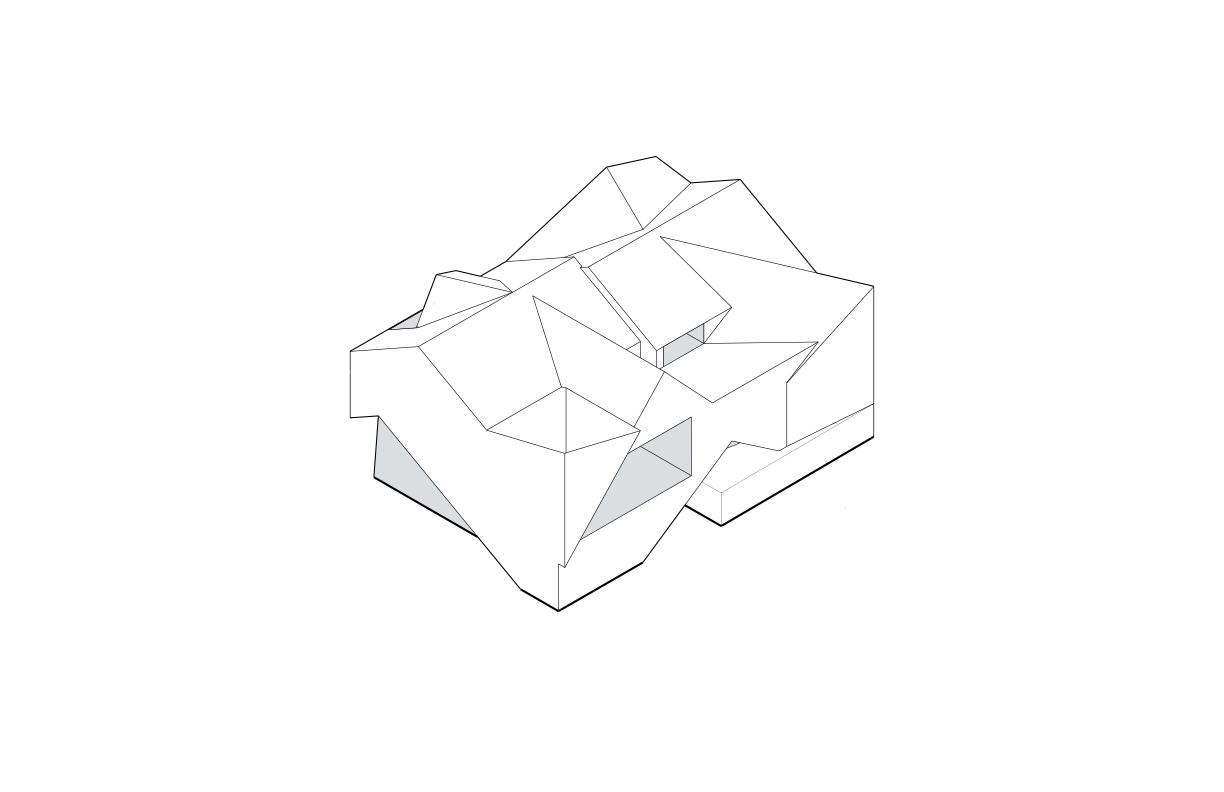
4
W.F.H
Post-Covid Office
Master’s 2020
Pages 21-26
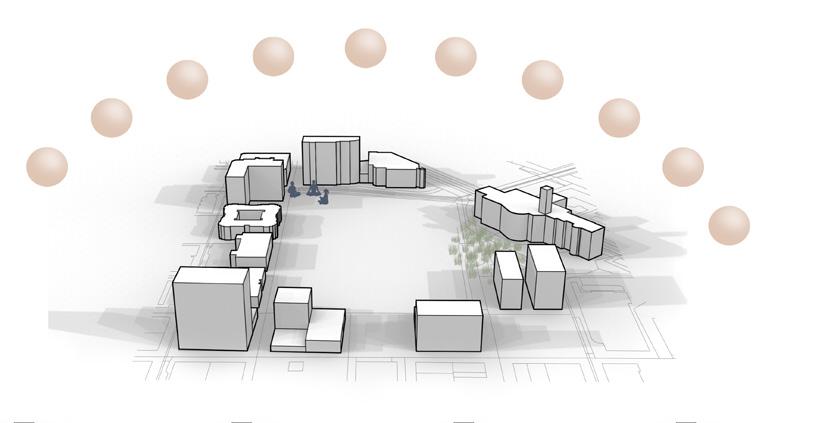
5
Small Projects
Mayo House Trails for Change URBANforest School
Pages 27-32

Professional Works
Renders, Plan Details, Sections, Schedules
Pages 33-36 6
A Gentle Density
PROJECT PARTNERS: Trayce Webb, Eric Deitering PROFESSOR: Justin Fowler MASTER’S 2020
Freedom, and connection, independence and community. These goals are what my team saw for our affordable housing project. Creating 200 housing units where there is currently only 40 required a heavy focus on interaction as this space would become a dense community. Creating housing that is socially engaging and economically and environmentally sustainable is a necessity as Portland continues to grow. Our site, Dekum Court, establishes this through a thoughtful private to public gradient as a neighborhood within a neighborhood.
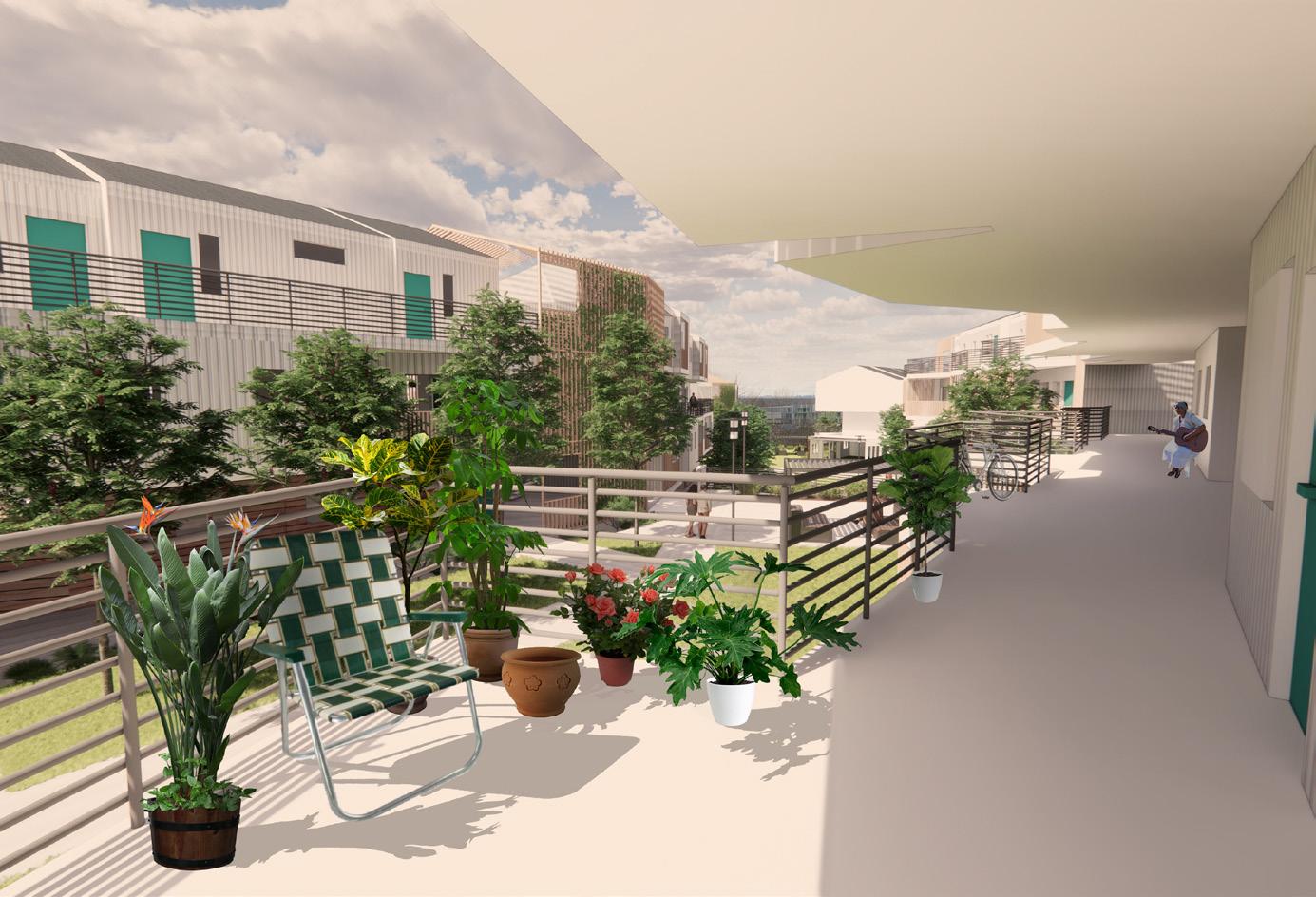


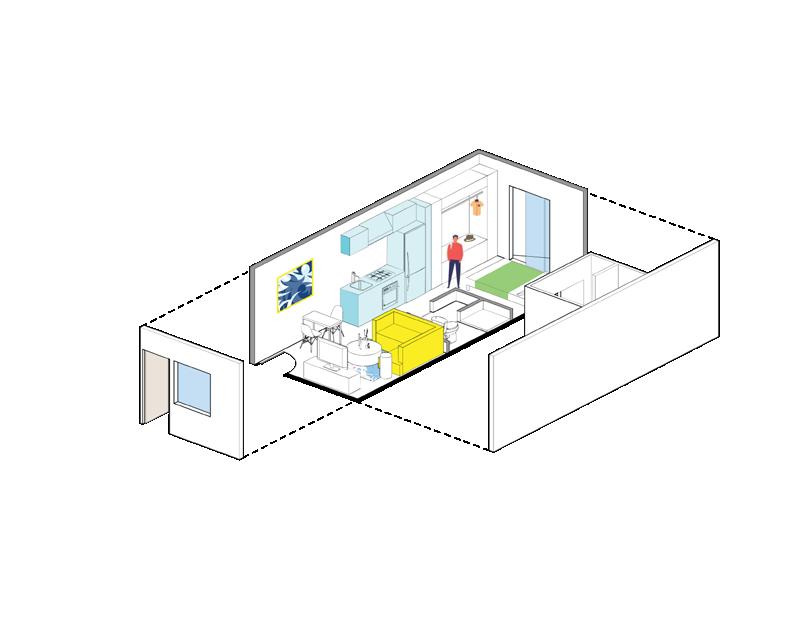






Water Conservation Method 1
Rain is collected from the roofs of paired buildings into an underground cistern to be stored for future household use or irrigation.

Water Conservation Method 2
Household water goes to a settling tank to process solids. Wastewater wetlands clean the water. Water is then more thoroughly processed through chlorine and UV treatment. Clean water is stored for future household use or irrigation.
Wastewater wetlands collects used water from the buildings, the water goes to a settling tank where solids are processed out. Wetlands clean the water then get more thoroughly processed by chlorine and a UV lter. Then the clean water gets stored for household use later, or used for irrigation.
Water Conservation Overview
Each roof collects rain water to a cistern placed in the middle of each pairing of buildings. Wastewater wetlands are shown at the north and south ends of the site, these connect to the settling tanks while also doubling as a space for rainwater runoff from rain catching streams placed throughout the site.
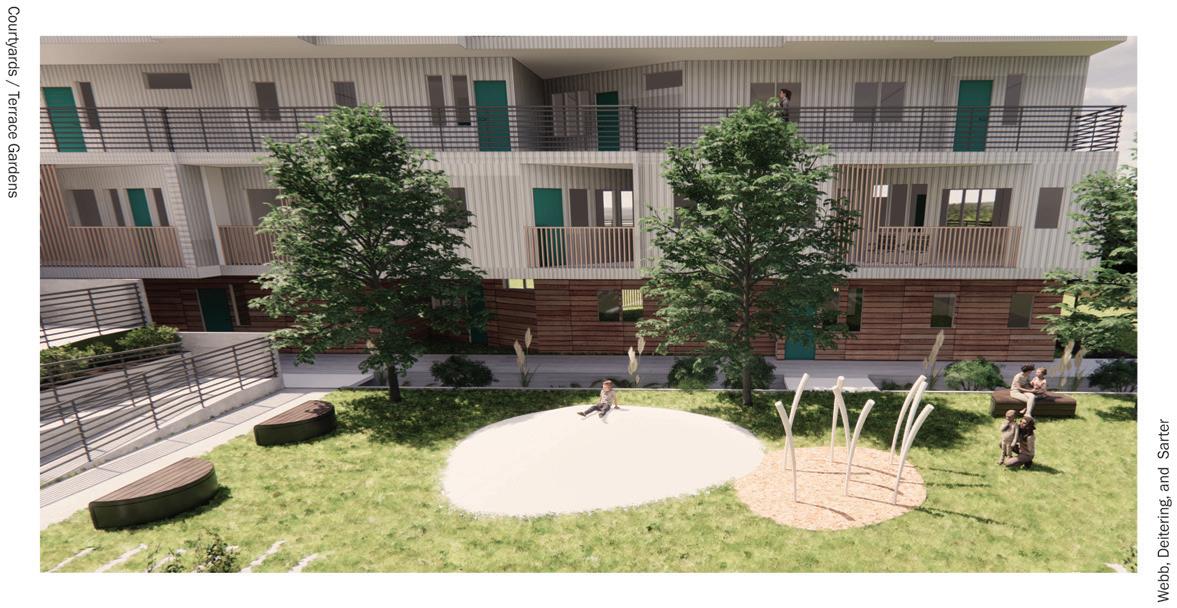

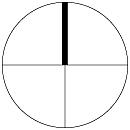

Micro Aquaponics
BACHELOR’S 2015
EXTRA-CURRICULAR
Passive System Study
I decided to create this passion project as I began to learn about sustainable design. Living in a city apartment my goal was to create a self sustaining system that brought the outdoors in at a small scale. After a few weeks of online research, trial and error with many different bell siphon designs, and questioning chemistry students, I was able to complete the experiment successfully. The water in the fish tank was staying clean on it’s own, and I was able to grow herbs and fruiting vegetables.
Equipment
The equipment included shows two bell siphons, an air stone, as well as it’s air pump, a water pump and the pipes that the water is released through onto the plant beds.

Support Structure
I chose to assemble everything onto a metal shelving unit in order to ensure durability as well as a shelf strong enough to withstand the weight of a 29 gallon fish tank.
Aesthetic Relief
Because this was designed to be in a home, I wanted functionality to blend with style. The wooden frame allows the system to feel warmer and softer than a metal shelf. The baskets below look like drawers making it relatable to a table or dresser.
2
Organic Matter Enclosures
A 29 gallon tank with a light and tank hood creates an environment for live fish. The plant beds allow plants and worms to thrive above.
ORGANIC

The rule of thumb for most fish tanks is to have a growing bed at about a 1:1 ratio with the fish tank. For this reason, I made sure the growing beds were big enough to cover about the same length of the tank.

For a 29 gallon tank goldfish work best. Round goldfish such as veil tail are ideal as longer goldfish would need more distance to swim. Goldfish also thrive in the same cooler temperatures as the plants.

Larger pieces of food waste that don’t get pulled into the water pump, or algae growths can be taken care of with catfish such as a plecostomus.
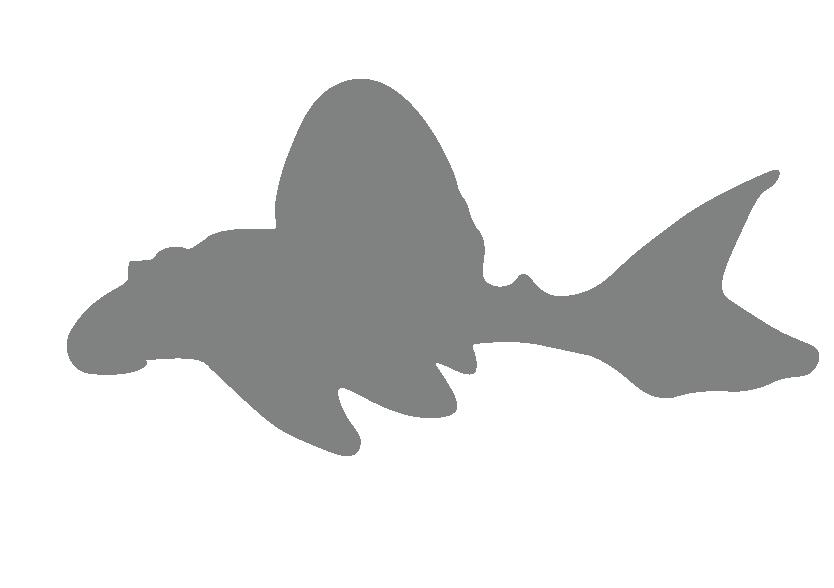
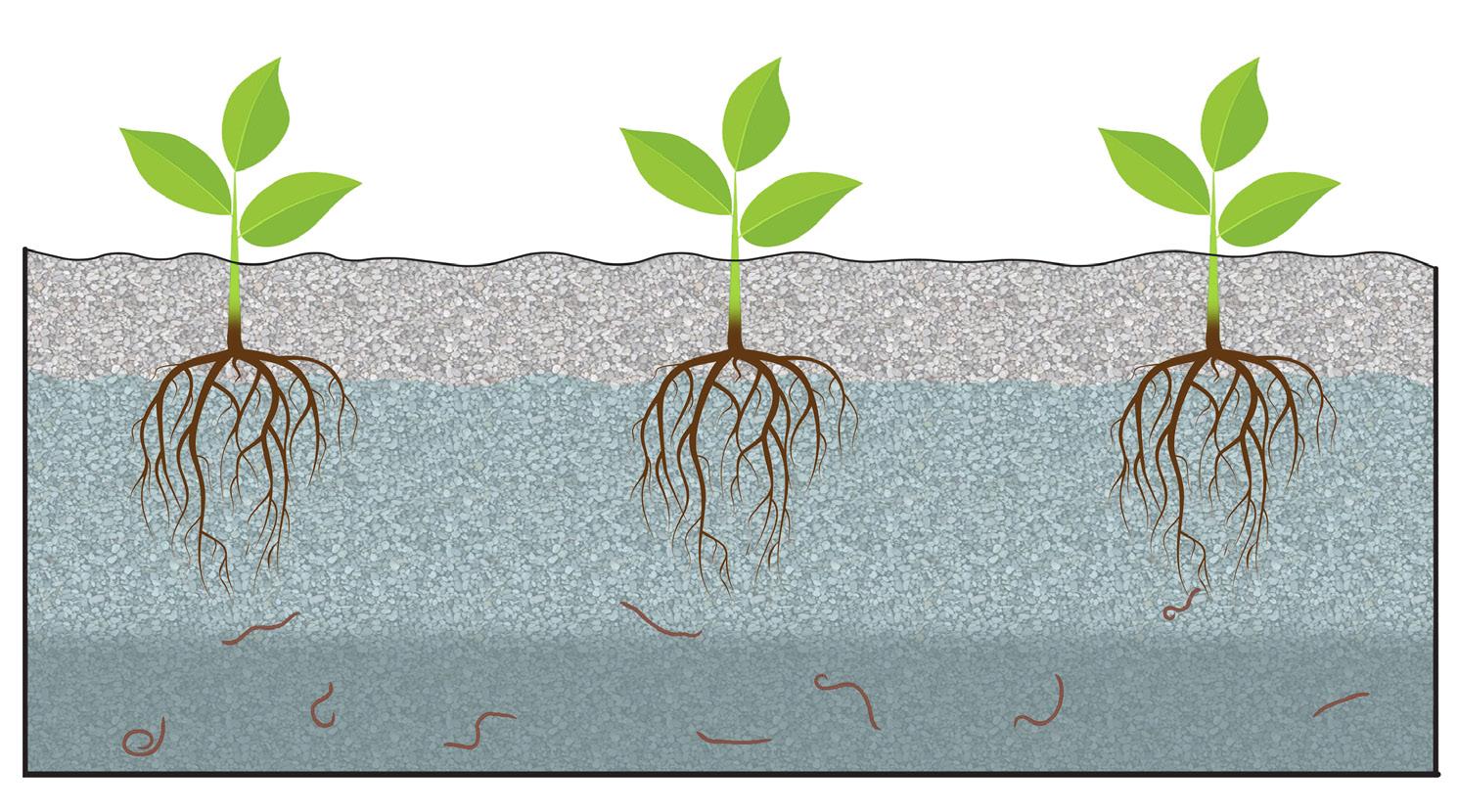
Red worms are placed in the plant beds to create compost from excess fish waste or dead plant matter. By getting rid of this waste they protect the plants from pests and disease.

A wide variety of plants can be used for the system, as long as it grows well in water. I have found success with cilantro, lettuce, chives, peppers, basil, and other “soft plants”.
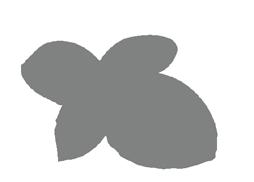

In commercial size aquaponic systems a preferable fish would be tilapia, which can be grown for consumption. In a 29-gallon tank goldfish work best solely to provide ammonia to the plants above.

Harder plants with woody stems are not ideal for aquaponics as the act of continually cycling water damages their stems.

ZONE 1: The dry zone does not get flooded. Having this zone stay dry at all times helps prevent rot, algae growth, and mildew from accumulating on the plants.
ZONE 2: This zone is where most of the roots of plants will grow. Water drains and fills completely in this zone, allowing oxygen to circulate with each cycle.
ZONE 3: In this zone fish waste and plant debris collect at the bottom of the plant bed. Implementing red worms into this zone helps turn this waste into fertilizer.
BUILT

Bell siphons allow water to drain in the grow bed so the plants can get breaks from constantly being in water. Inner drainage creates the different zones.
Media Guard
The media guard encases the bell siphon with perforations large enough for water to flow through freely but block media from plugging the system.
Bell
The bell only allows water in through the bottom. The seal creates a vacuum until water levels reach the accelerator opening, restarting the flooding process.
Two PVC valves are used to fill each plant bed with water from the fish tank through a water pump.
Accelerator
The accelerator is attached at the top of the stand pipe, it creates a smaller gap compressing the water and accelerating into the pipe.
The timer is set to run on 15 minute intervals through every hour. I found that this is necessary to allow the grow beds to drain.
Oxygen is critical for a functioning system. By adding an air pump with an air stone, oxygen is constantly being dispersed.
Stand Pipe
A water pump that disperses water at 420 gallons per hour was enough to carry the flow up from the bottom of the fish tank and into the plant beds.
An LED bulb illuminating the tank was the best option for minimal energy consumption as well as minimal heat transfer to the water.
The stand pipe is a vertical pipe that connects most pieces and water runs through.
Water Break
This allows maneuvering of where you want the water to enter the fish tank.
Max. Water Level
The highest the water can flood to before it starts to drain into the pipe.

DID IT WORK?

A pH balance chart looks at acidity to alkaline levels, acidic being 1 and alkaline being 14. Pure water sits at a 7 which aligns closely to the pH levels of the living organisms of the tank. My system came close with a pH level coming up on 7.4
The ammonia levels determine how well the fish waste is being processed. As shown in the detector the plants are processing ammonia as fast as it’s being produced.


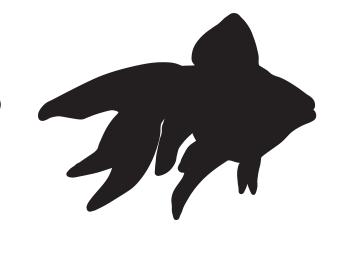

Fish are fed. Fish produce ammonium. Nitrosomonas oxidize ammonium into nitrite.

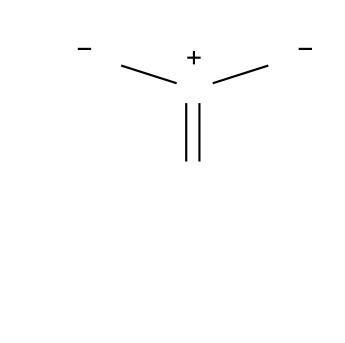
Plants absorb nitrates as fertilizer.

Nitrospira oxidize nitrites into nitrate.

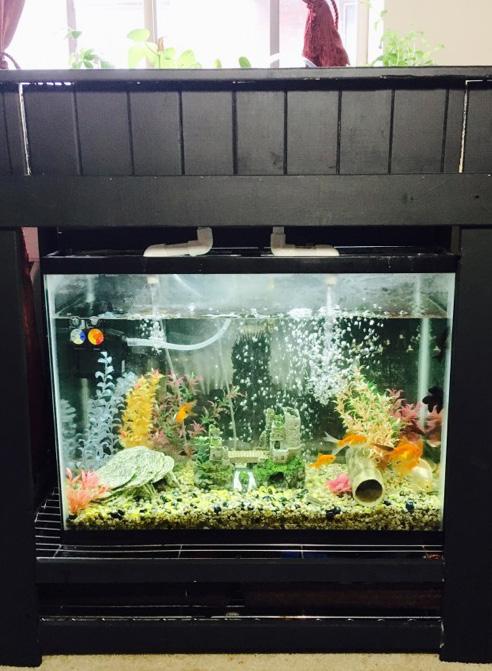


Juniper Ridge Cellars
BACHELOR’S 2016
SPRING TERM
PROFESSOR: Filip Tejchman
This project’s challenge was to create a sustainable winery fitting to Napa Valley. We studied different passive systems that would fit our designs. I chose a down draft cooling tower, a small scale interpretation of stepwells, and solar shading techniques. The cooling tower is in the shape of a crescent to blend with the design of the fermentation area and retaining walls. The stepwell takes form of reflecting pools alongside an intricate stair that doubles as shelving for the wine. My goal was to create an inviting atmosphere that pays attention to the merging of guests and employees as a working and visiting space.

Grapes are brought from the vineyard to the crush deck to extract grape juice from the berries.
The grape juice is brought to fermentation. Grape juice is put into the fermentation tanks where yeast is added and will turn into ethanol within a few weeks.
Guests have the option to enter from the southwest main level where they have a choice to taste wine in the bottling room peering over the vineyard through a large glass facade. From here they can take the stair or elevator to the gathering area, where they will start tours of the barrel room below, and the fermentation room to the north. The fermentation room has a public access platform where people can taste wine while watching the work be done from a view that’s out of the way of production. Employees may enter through this same entrance or another road on the North Eastern edge.
Wine is then stored in oak barrels where flavors and tannins will develop over a longer period of time.
Last, wine is put into bottles and stored where it will either be sold or saved in a wine library where one can go to refer to different vintages and flavors.





We used computational fluid dynamics (CFD) to test the heat patterns through the tower into the fermentation room. Using this technique allowed me to test if my design was accurate. I was able to achieve temperatures within the mid 60 °F-70 °F range within the fermentation room.

June 21st
Summer Solstice
March 21st
September 21st
Equinox
December 21st
Winter Solstice
The glazing wall of the bottling room is angled to allow the winter sun in as well as the equinox sun over the pools. The summer sun is blocked so as to not allow heat in. As the temperature doesn’t vary to extremes in the region, the winter sun can help with most of the heating of this room.
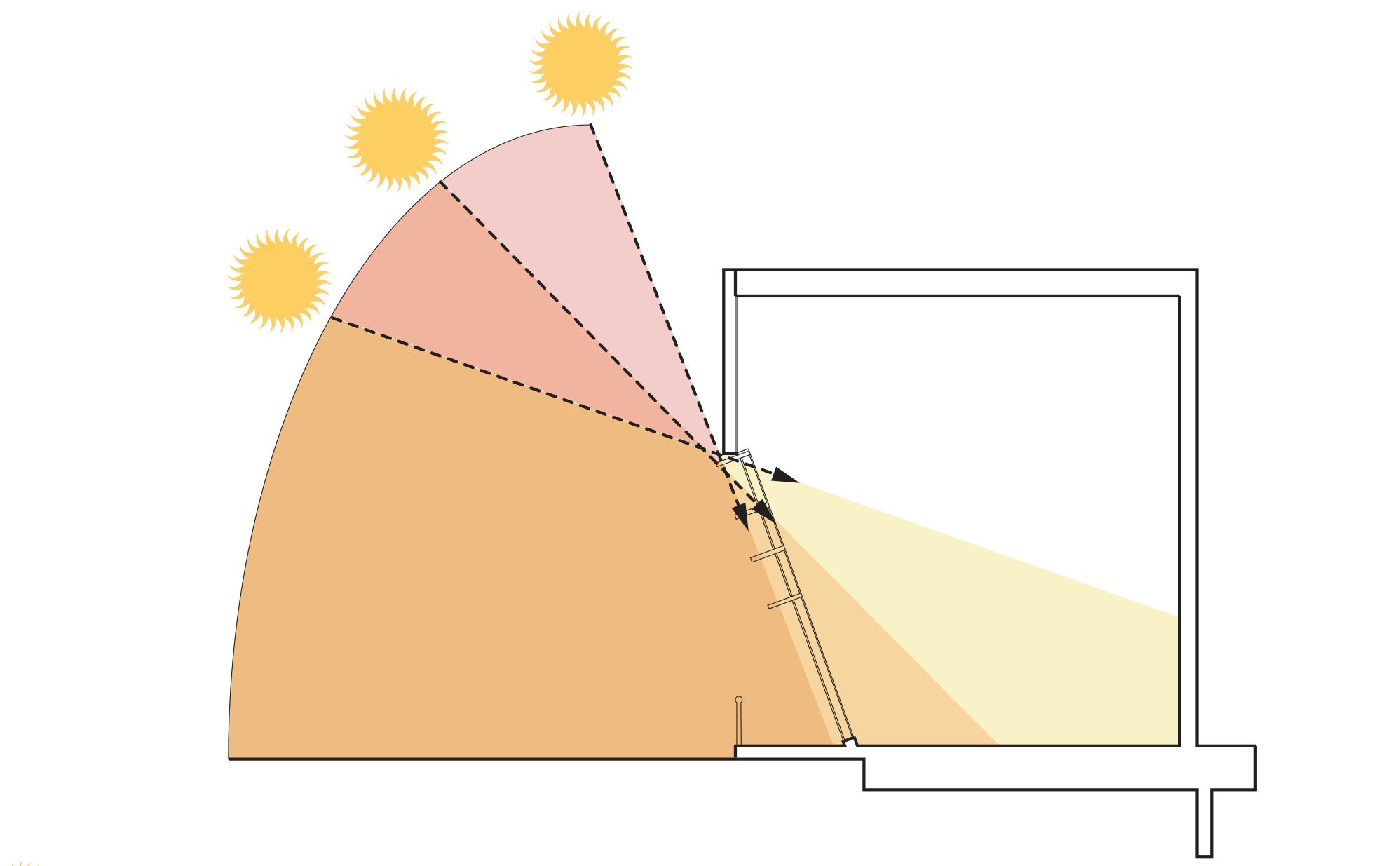

Sun heats the top of the tower and the bottling room. The towers cool the air and it’s pushed through the fermentation room through compression. The fermentation room produces the most heat because of the tanks, so it is best fitted to get direct access to cooling. A cloud shows the evaporated water coming from the reflecting pools. Once the pools have heated enough, evaporative cooling is used to cool the air in the room.
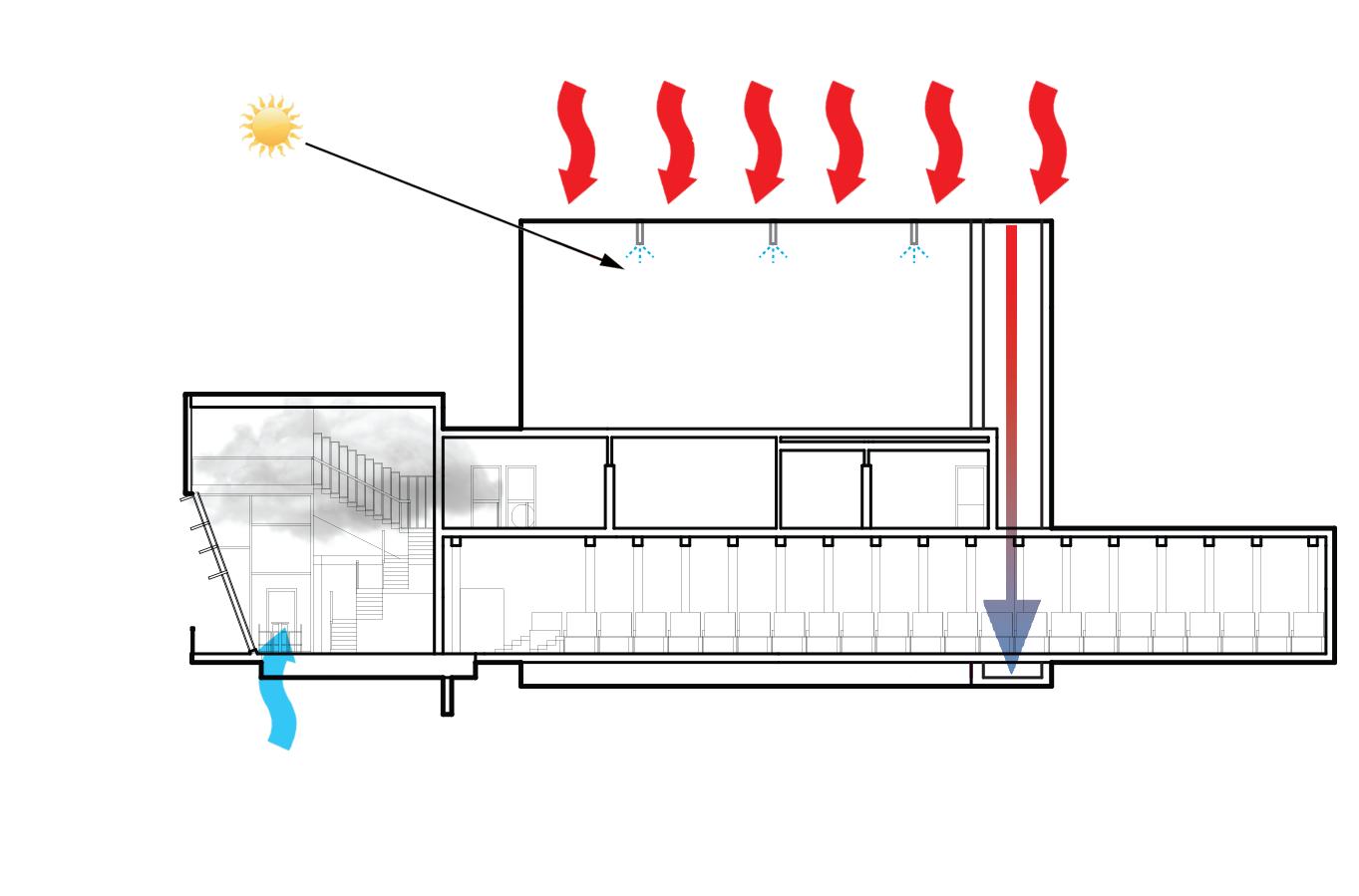
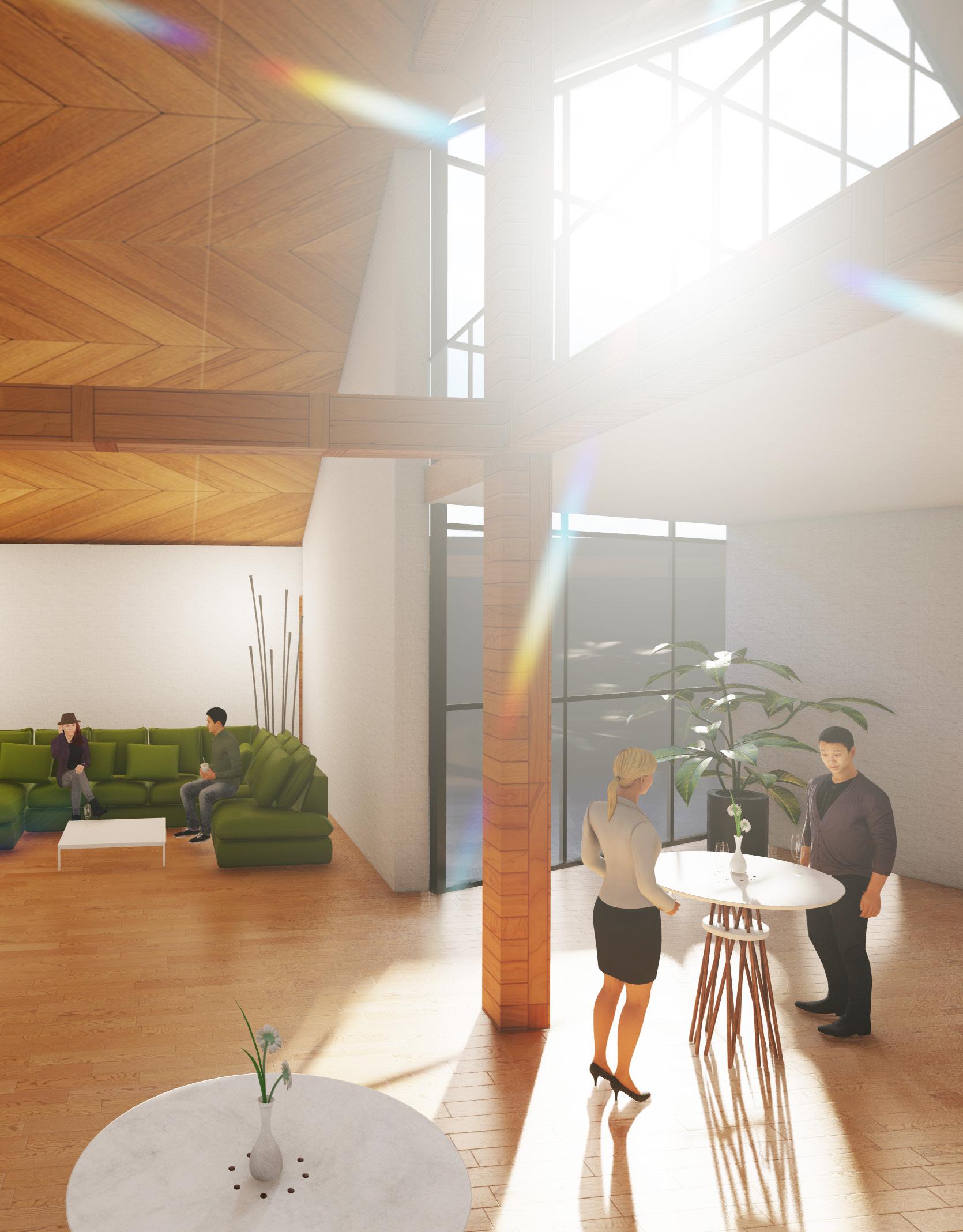
W.F.H.
MASTER’S 2020
FALL TERM
PROFESSOR: Clayton Taylor
This post-Covid studio looks at what future offices may look like after the pandemic. What will employees miss about working from home? How can we prepare for future pandemics? My design starts literal, using a gable theme to create my modular shape. A series of cropped gables and triangles continues down to the refinement of material choices. Within the layout of the building my main goal was to give employees autonomy of their workspace. This was done through seating, whether that be in a desk or on a couch, inside or outside, or with their team or in their own space. This combined with abundant natural light, bright colors, and interesting textures makes for an engaging environment.
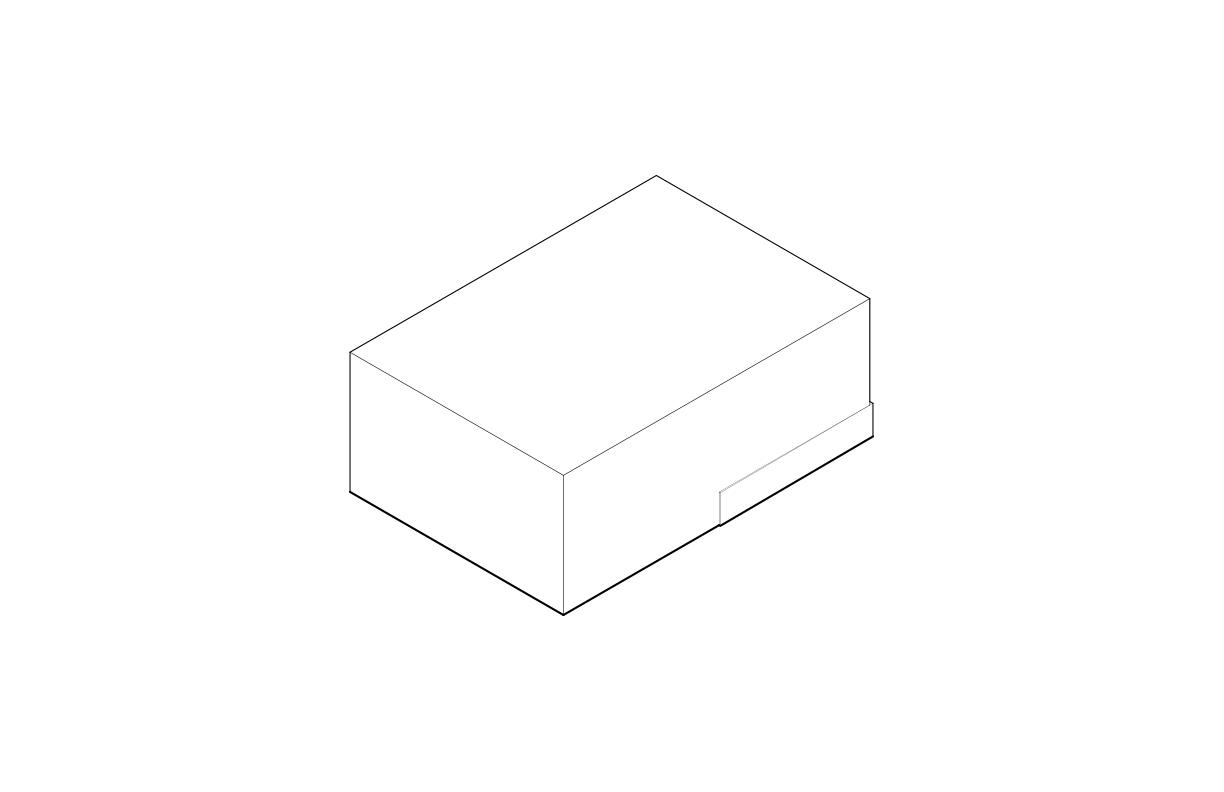

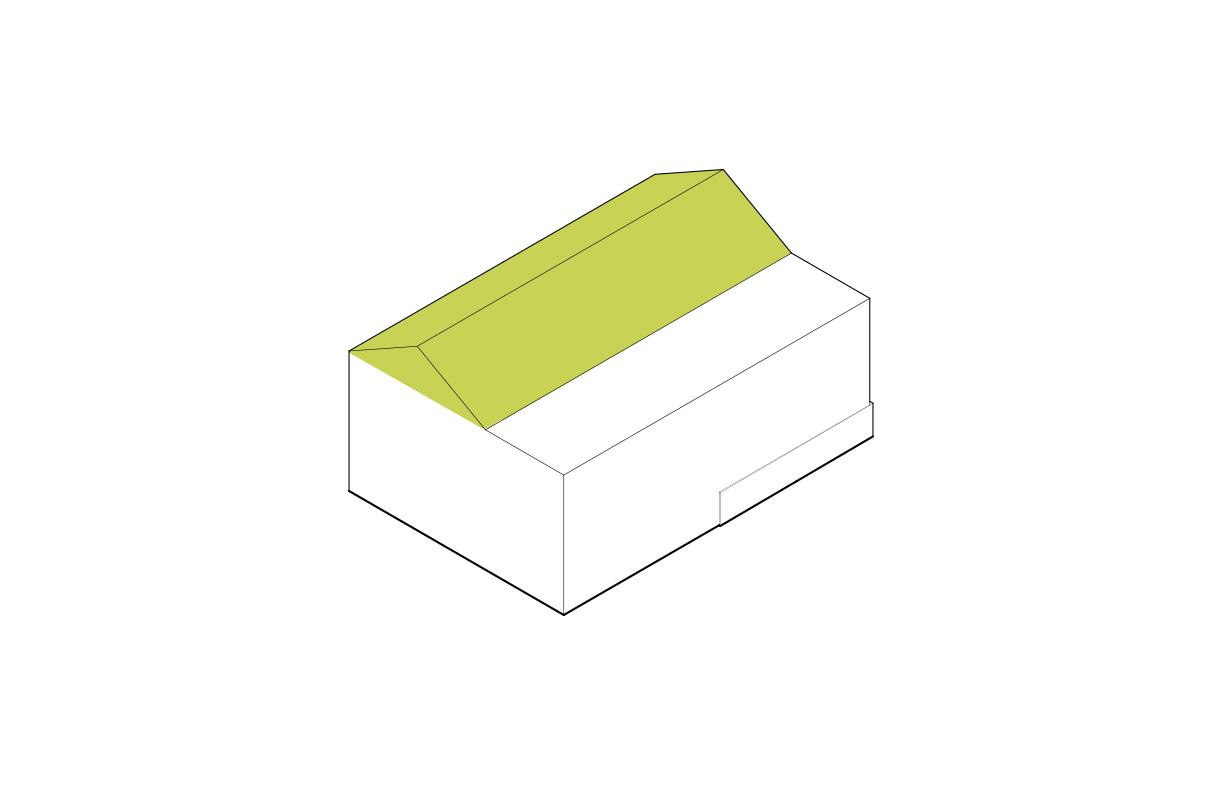
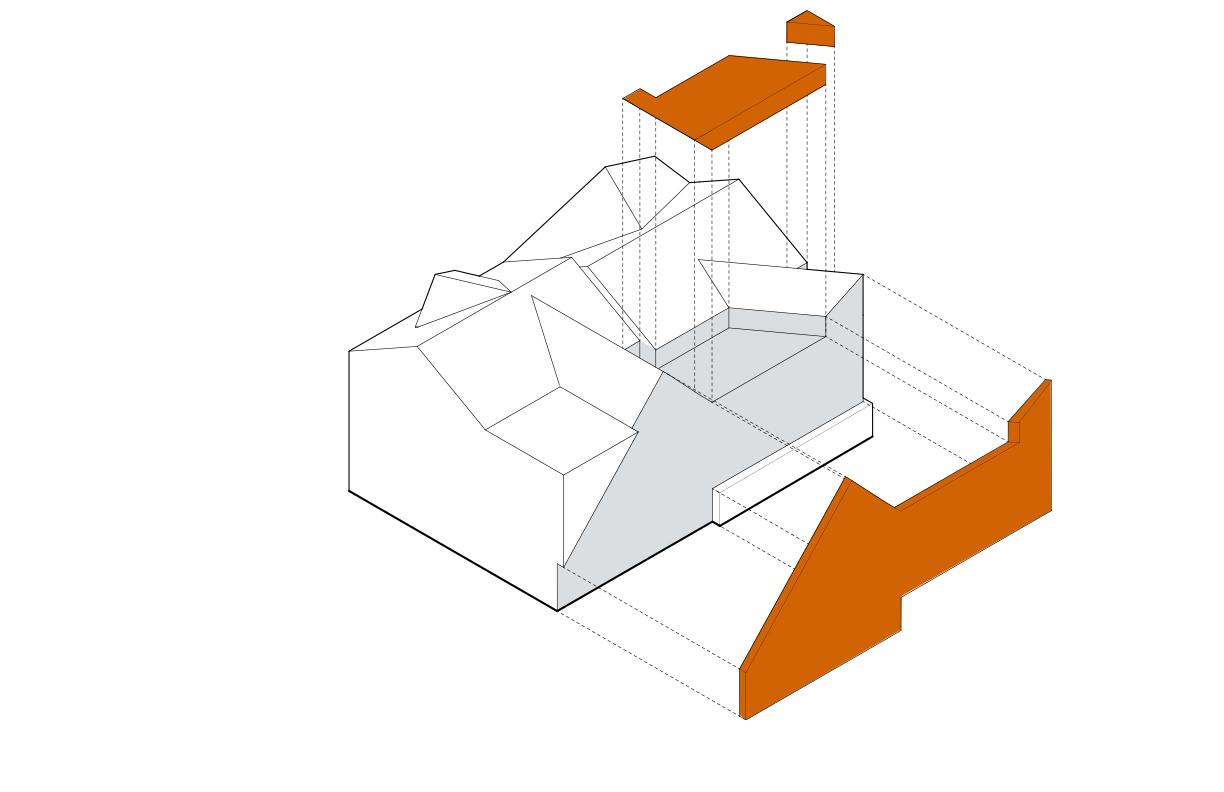
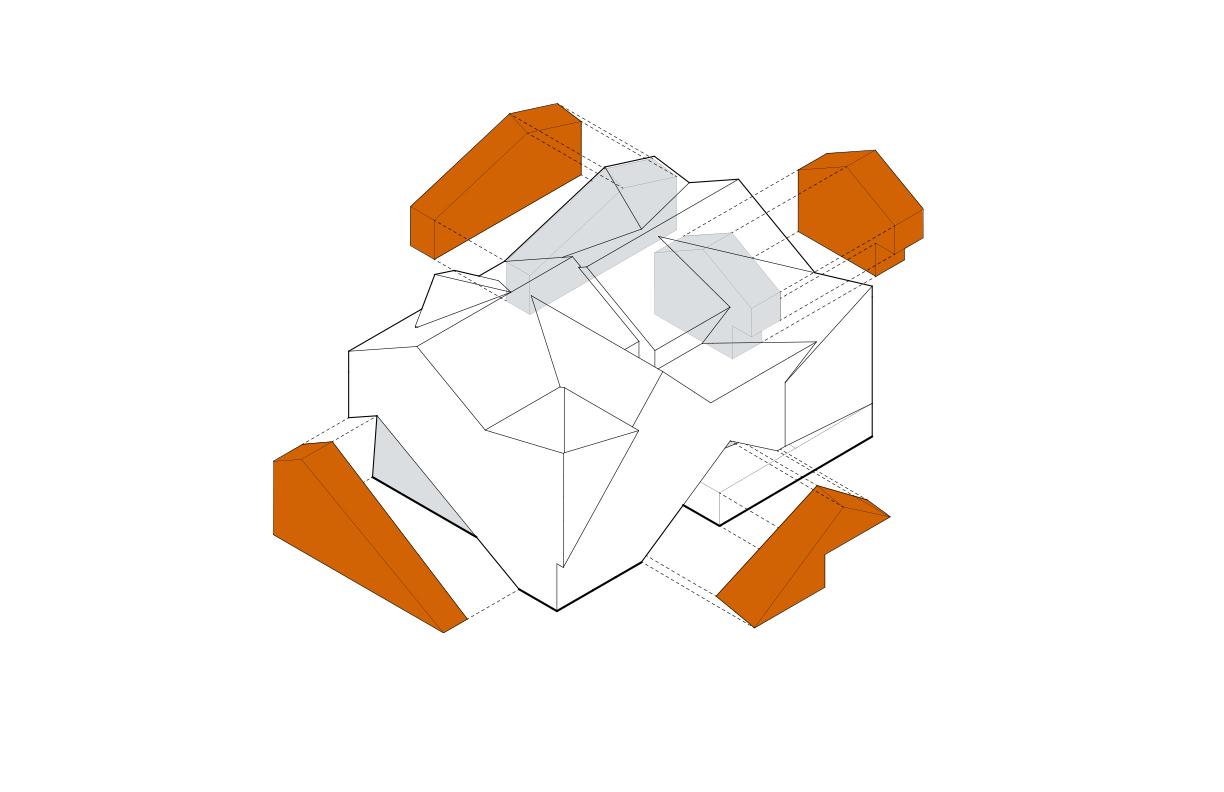

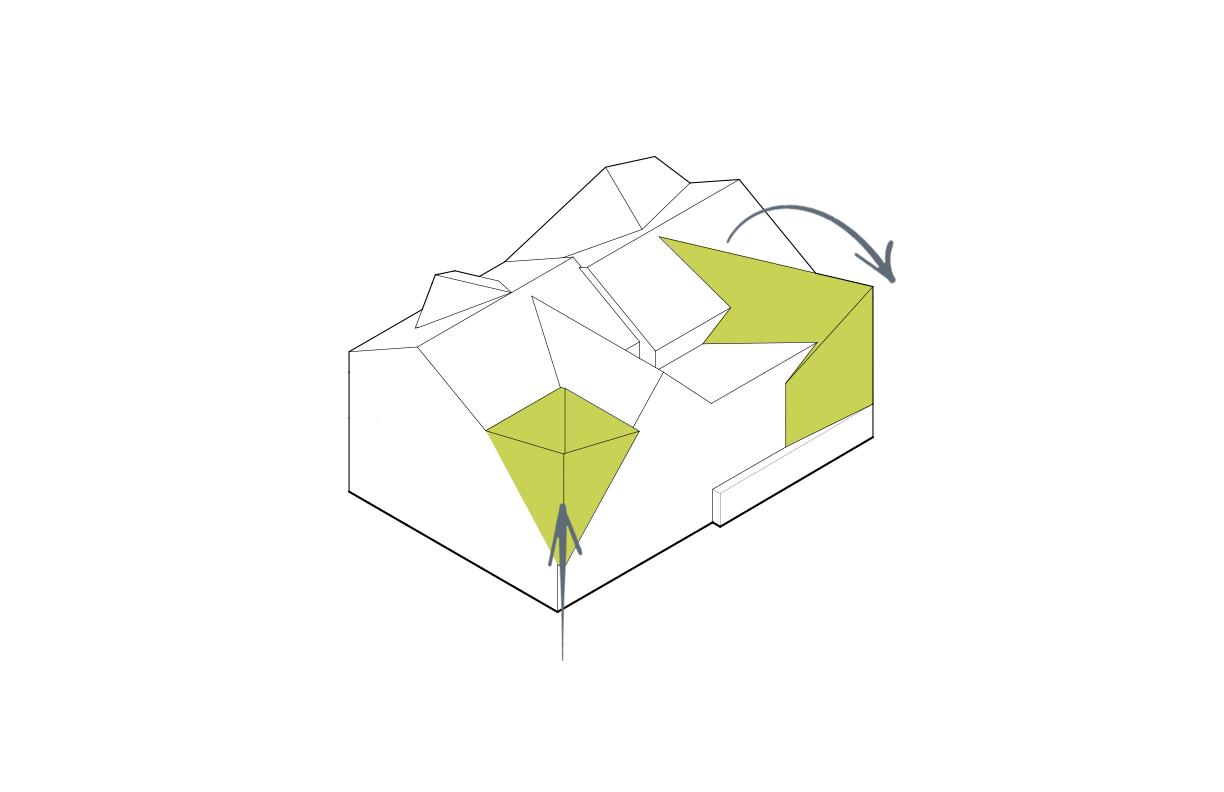

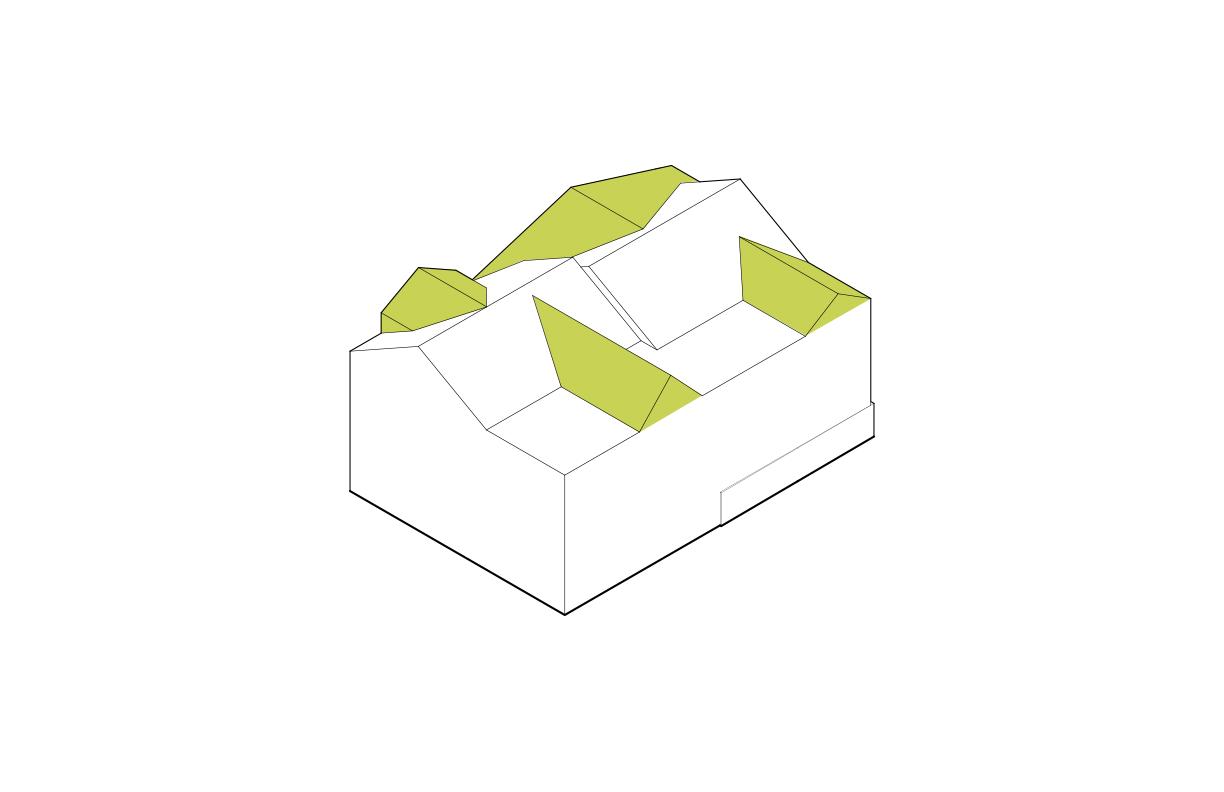

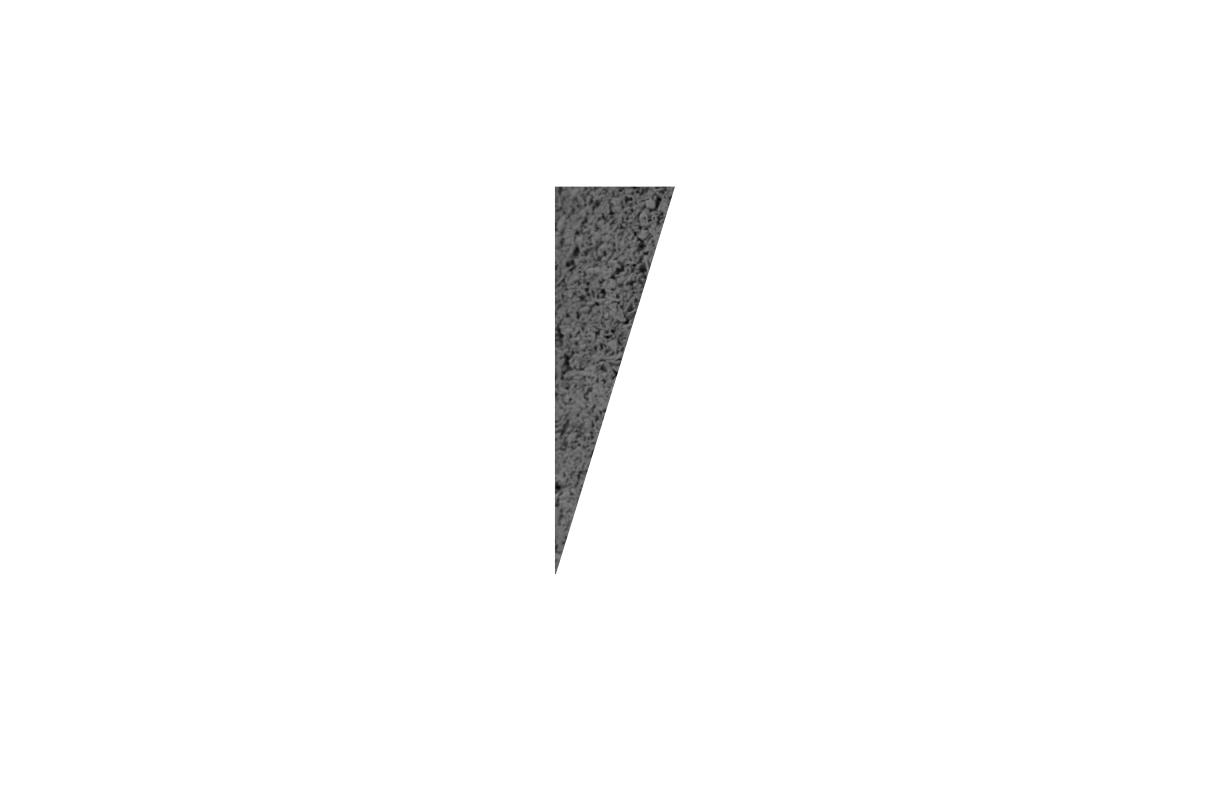
-Fast growing
-Local Material
-Stronger Than Concrete


Hempcrete Slate Green Roof
-Fast Growing
-Anti-bacterial
-Soft Look
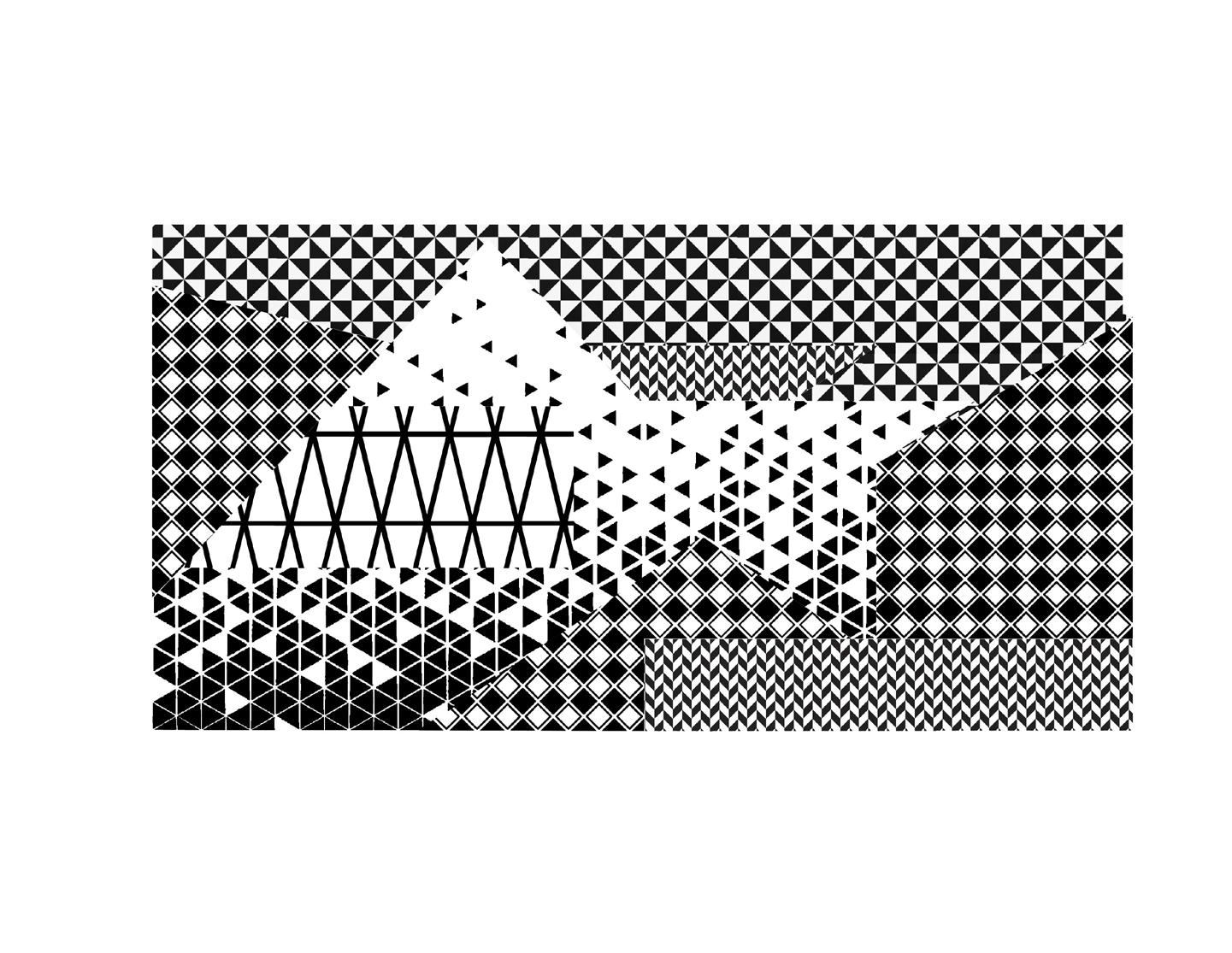

-100% Natural -Recyclable
-No Emissions
-Biodiversity
-Passive Cooling
-Rainwater Control
A facade study was created with a series of triangular patterns that translated to the facade of the actual building through patterned hempcrete, wood grain, slate roof tiles, and deciduous trees. Materials were chosen keeping potential pandemics as well as sustainability in mind.


Air Circulation
Windows and pass-throughs offer ample fresh air throughout the building.




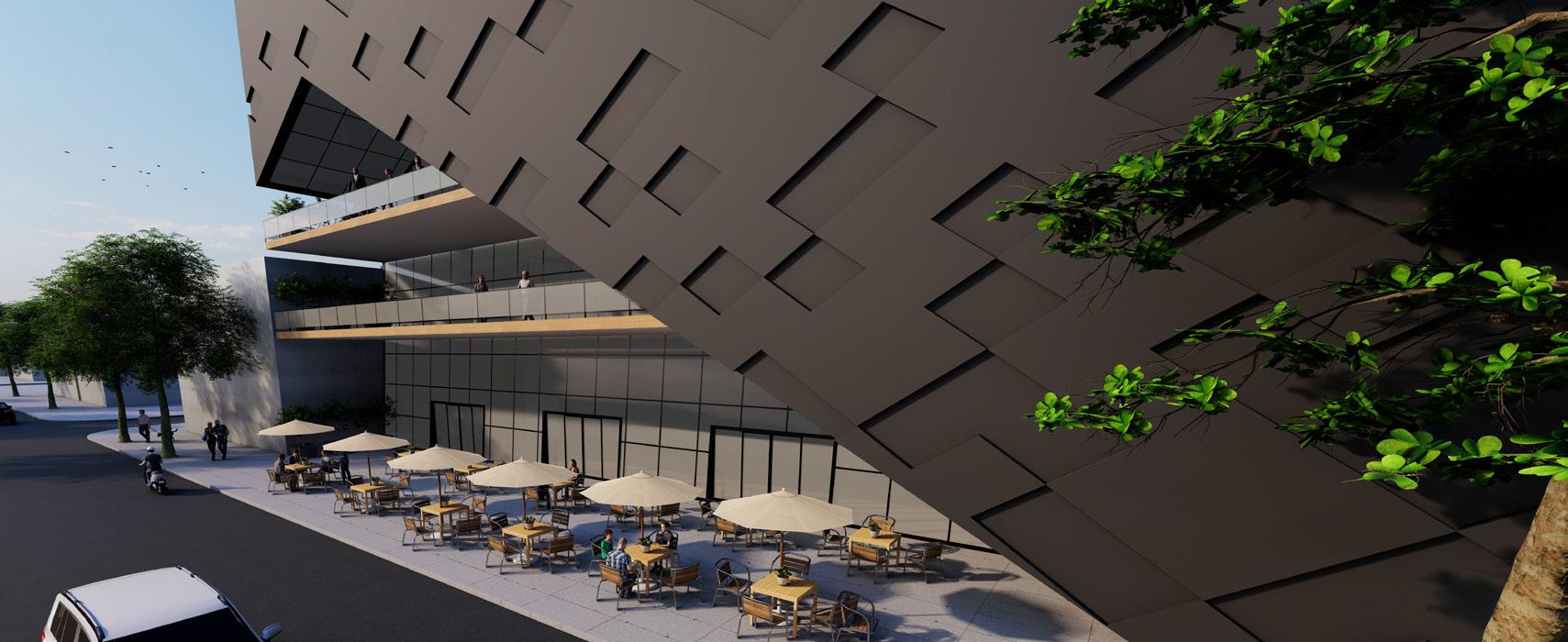
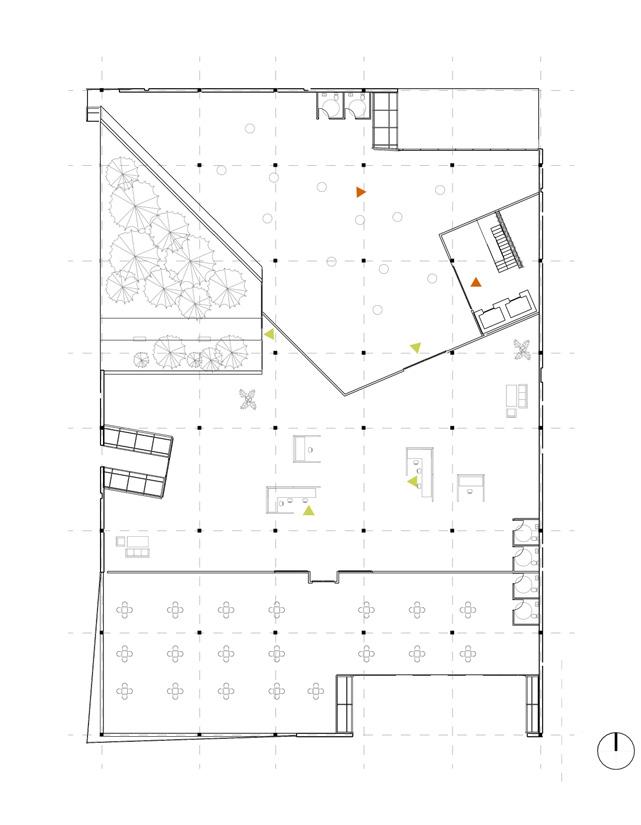

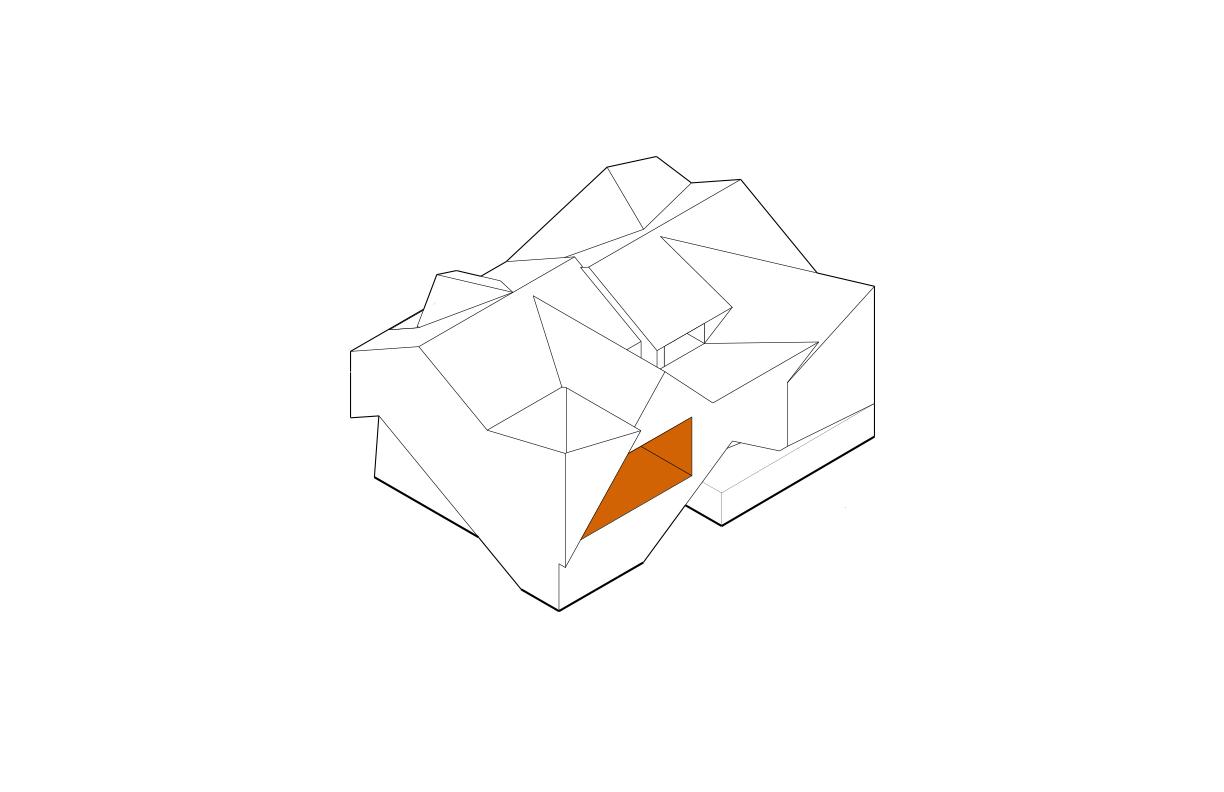
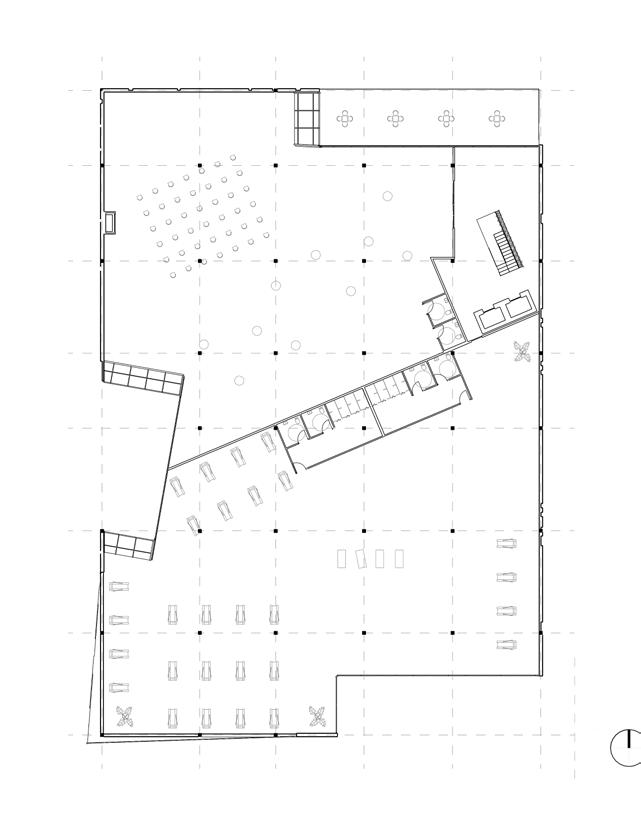
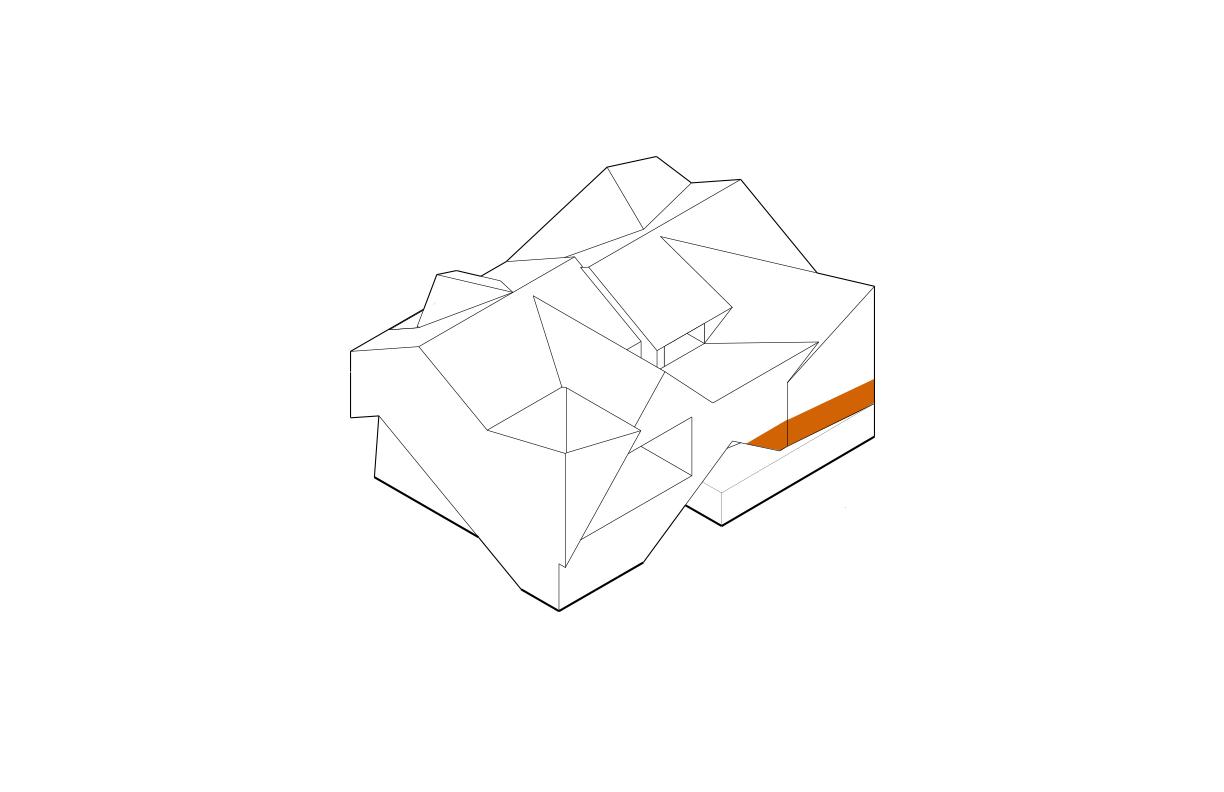
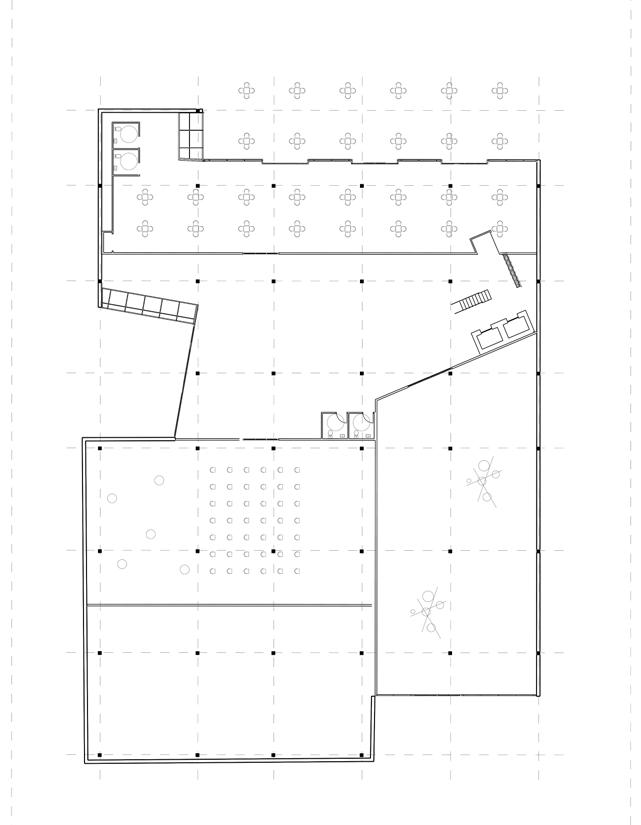

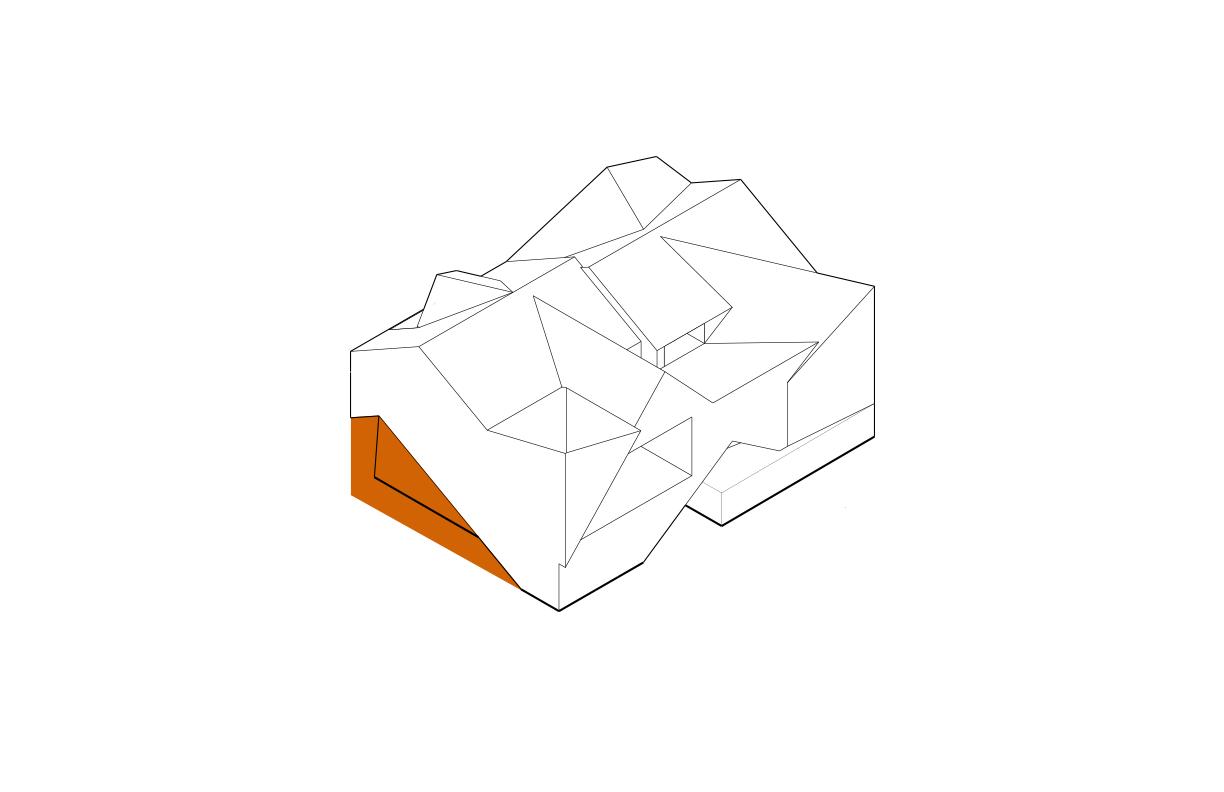
SECOND FLOOR GYM
FIRST FLOOR RESTAURANT
THIRD FLOOR PARK

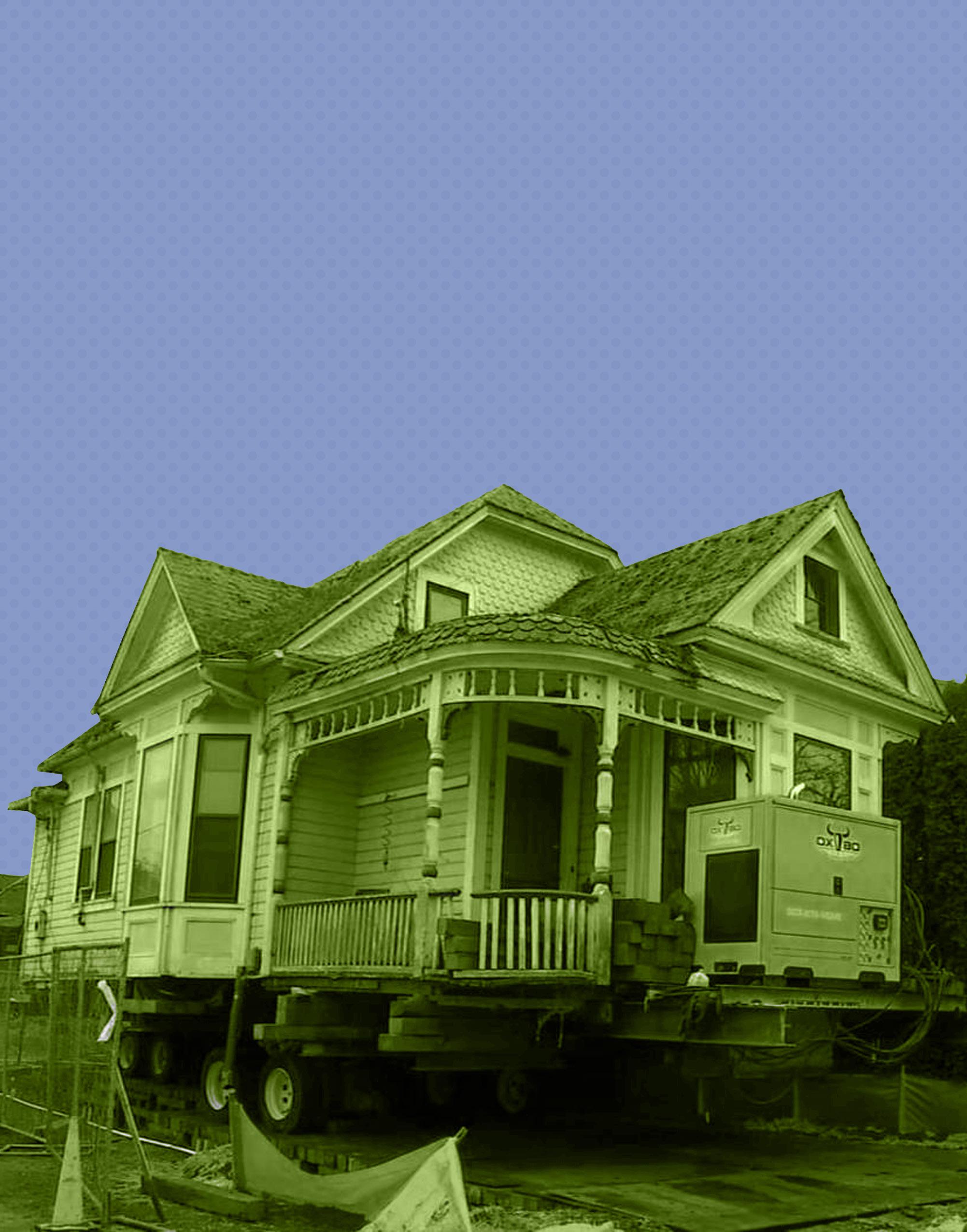
Mayo House
MASTER’S 2020
PROJECT PARTNERS: Danielle Valdez, Cameron Reid, Rebecca Kiefer
PROFESSORS: Craig Wilkins, Kayin Talton, Cleo Davis
My current terminal studio, “Rebuilding Cornerstones” focuses on the Black history of the Albina neighborhood. For studio prep, my partners and I were tasked to create a report on the Mayo house in a format that can be accessible to the public. We chose a video presentation of a potential children’s pop up book complete with interactive tabs. The Mayo House has a rich history in the Albina neighborhood. It represents perseverance in securing the history and culture in the neighborhood by overcoming eviction and demolition by becoming an art and cultural center for future generations.

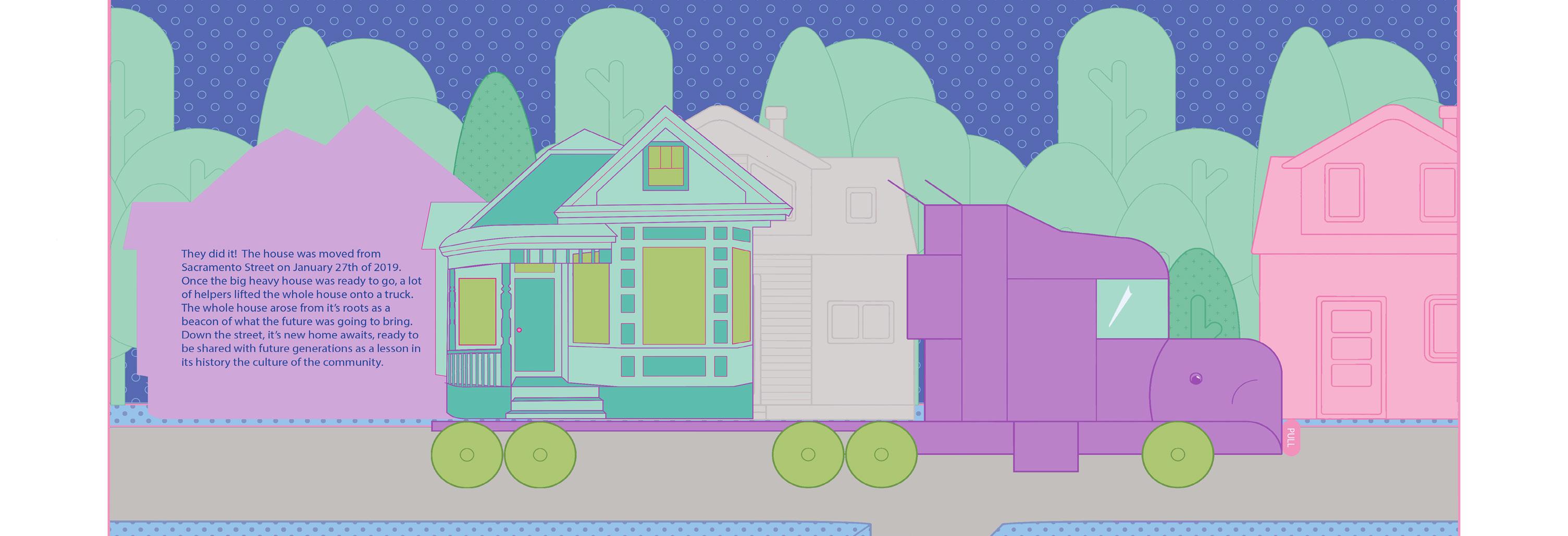



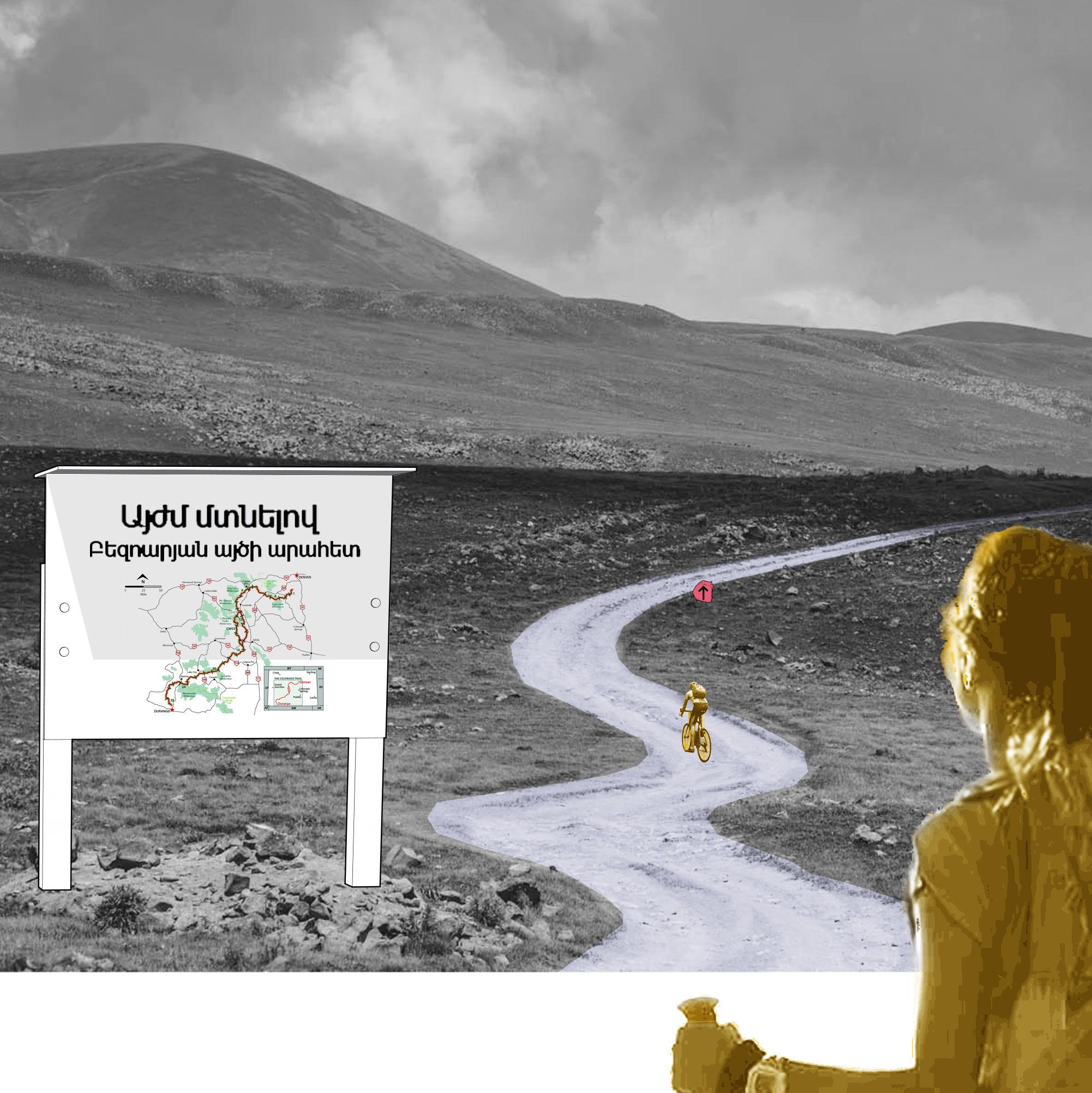
Trails for Change
MASTER’S 2020
DESIGN ACTIVISM
PARTNER: Ian Oakes
PROFESSOR: Craig Wilkins
This is an existing NGO in which we explored costs and funding to maintain trails in Armenia. Genocide of WWI wiped out many of the villages in Armenia, and to preserve these trails is to preserve part of those villages and create an opportunity for locals to learn trades in land stewardship. We specifically focused on“Bezoar Goat Trail”. Costs of materials and supplies were researched and translated to Armenian Dram (AMD) to get an understanding of how much was needed. Outside of grants, we looked into fundraising events such as a bicycle race that could bring in funds through local food and entertainment.

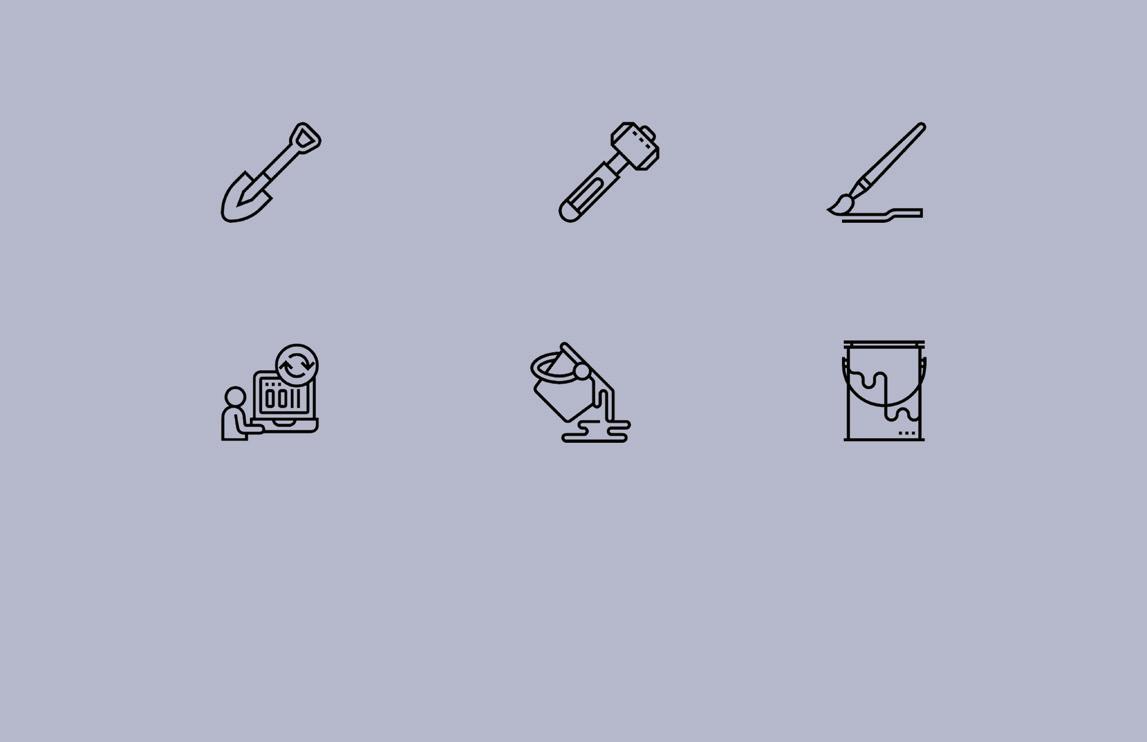



















URBANforest School

HUMAN CONTEXT OF DESIGN
PARTNERS: Anna Kick, Emily Post
PROFESSOR: Yosa Huggins
For this class we created a building analysis report that looked over social, environmental, psychological and cultural aspects that an elementary school would benefit from. Aligning with the NGO “Peace in Schools” our focus was on the benefits of meditation and a connection to nature. Our approach to a mindful school looked into program based on circadian rhythms and learning styles unique to individual student needs. Students of all learning styles would have tailored spaces to their learning requirements in order for every student to reach their full potential in a space that works best for them.

You might be a social learner
What is Your LEARNING STYLE?
Imagine your happy place. This is where you feel safe to engage & explore the world.
Who are you with?
Friends and Family Myself
What activites are you using to engage?
You might be a solitary learner
Singing songs Watching a movie Having a chat Working on a puzzle Dancing

Social learning styles allow children to engage with one another to form their ideas.

Visual styles will include images, pictures, and colors.

Kinesthetic styles activate a child’s learning through touch and physical activities.

Verbal styles involve reason and problem solving through language.
Listening to music Running or stretching Drawing Reading

Auditory styles will engage students through listening, speaking, and music.
Listening to a podcast

Logical learning styles include order and pattern.

Solitary style allows students their own space to come to conclusions on their own.

https://issuu.com/alexandriasarter/docs/building_analysis_space_needs_summary_lexi__anna__



Professional Works
POST GRAD 2021-2024
JONES ARCHITECTURE
For my professional work samples, I’ll be drawing from my time at Jones Architecture, as much of my work at Bright Black Design is protected under client confidentiality agreements. At Jones, I was involved in a wide range of projects across all phases of design. I worked on various schedules and developed details from schematic design through construction development. I carried plans, sections, and elevations through each stage of the design process. I also expanded into marketing and interior design, creating renders and mock-ups using hand sketching, Adobe Creative Suite, and Lumion.

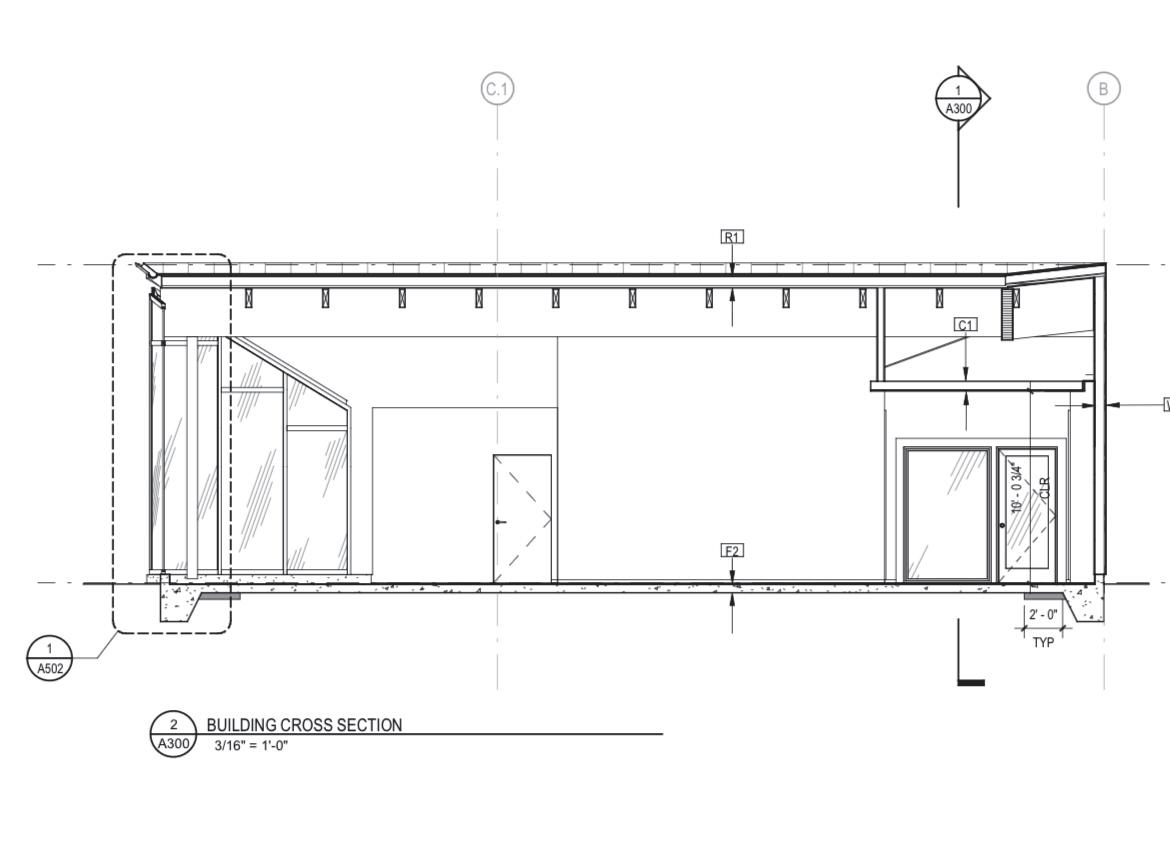

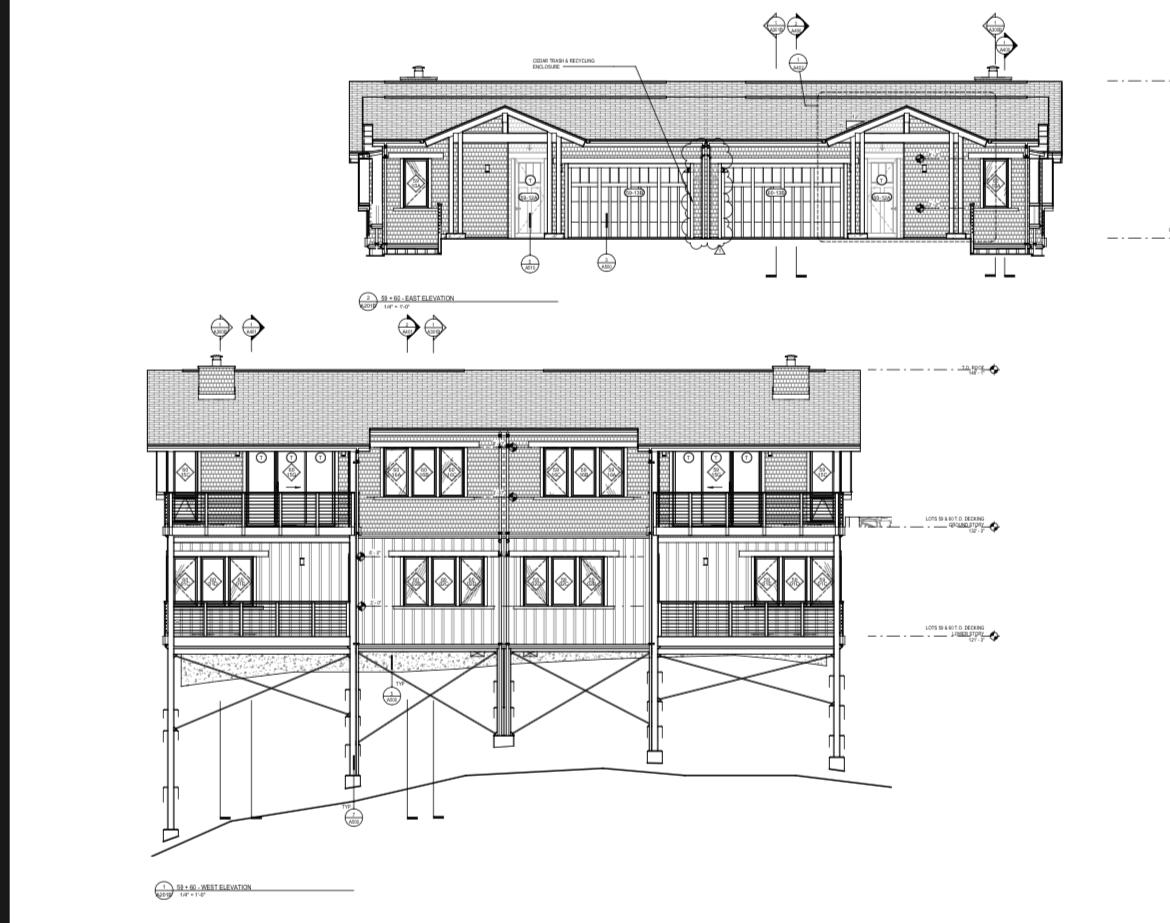


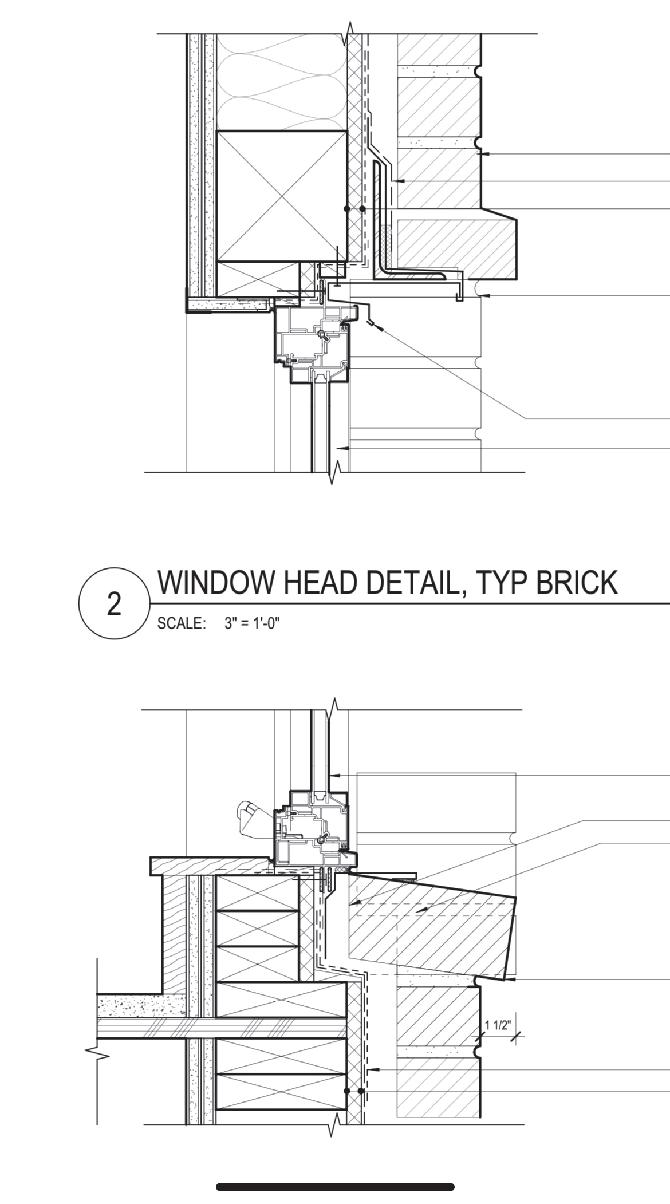

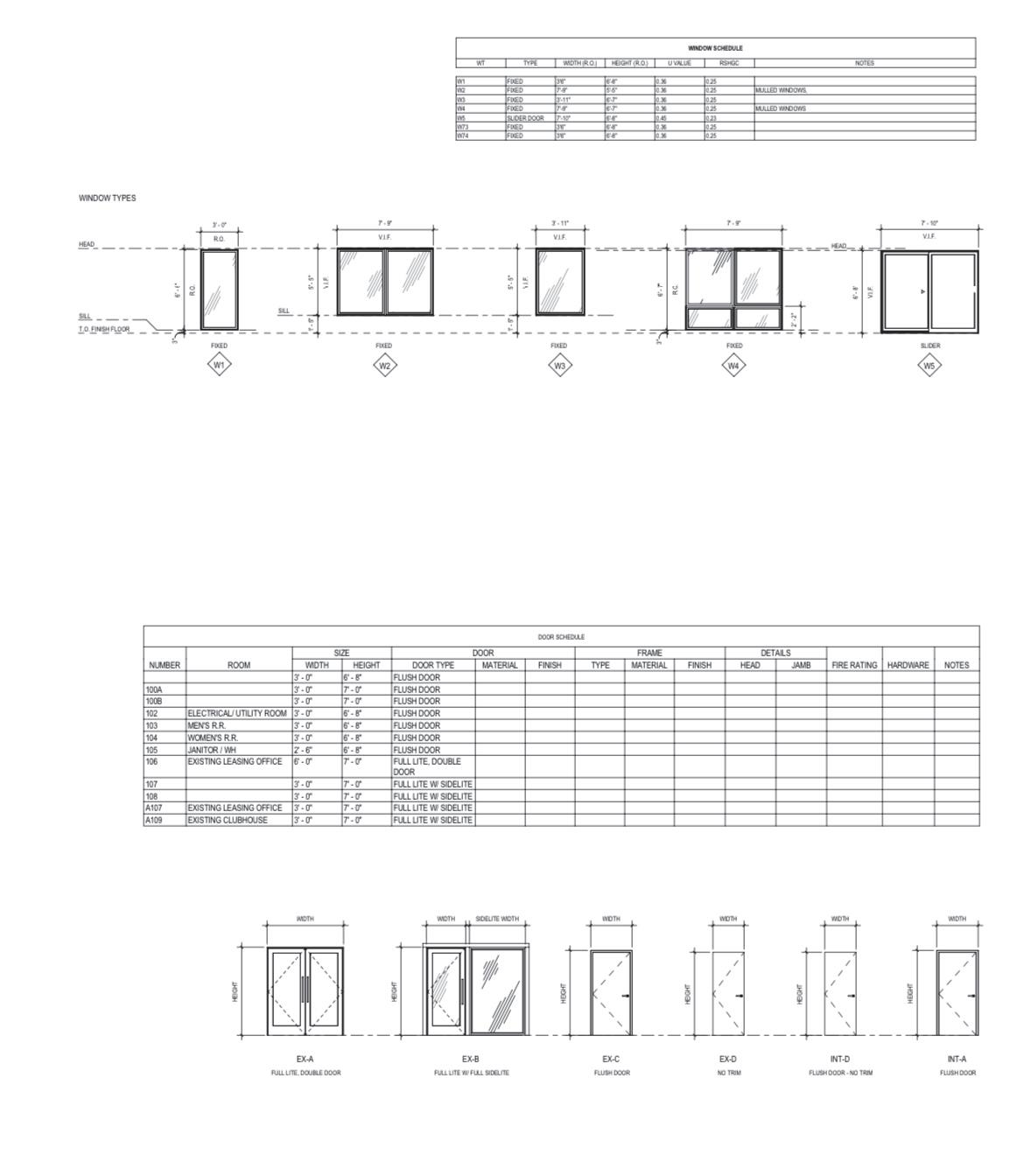


THANK YOU.
